#Even it's name is bursting with creative word combo
Explore tagged Tumblr posts
Text
Screaming and crying screaming and crying screaming and crying screaming and crying-

I understand thinking Meganium is the worst Grass Starter (even thought it's my second favourite Grass final evolution :c) because it's moveset sucks
I understand thinking Emboar is the worst Fire Starter because it's the third Fire/Fighting Type and people were sick of them (even though his design inspiration is FUCKING AWESOME because it's based on Journey to the West like Infernape is and it's a FLAMING BOAR)
But Quaquaval? FUCKING QUAQUAVAL?!?!?!?!?!?!?
Haters can't handle a fruity Carnivale duck, so sad. 😔
#pokémon#quaquaval#emboar#meganium#Wow how can someone be 100% wrong#Like come on its literally Water Blaziken#Don't see anyone hating on Blaziken now do ya?#I think the only reason why people hate Quaquaval is because of the New Starters Are The Worst thing that's been going on since 2011#Even it's name is bursting with creative word combo#It's Quack + aqua + Carnivale it sums it up to a tee#I think the worst Water Starter is Hisuian Samurott#Samurott was already underwhelming but then they turned it into someone's edgy DeviantArt OC#AND THIS IS COMING FROM SOMEONE WHO FUCKING LOVES SAMUROTT TO DEATH#IT WAS MY FIRST POKÉMON I GOT IT'S PLUSHIE#Quaquaval's got a really creative design#I'm on Team Sprigatito but I won't stand for the Quaxly slander
25 notes
·
View notes
Text
Fate x Bleach: What if Ichigo became a SERVANT?
Random idea of having Ichigo from Bleach as different Servants from the Fate-Series.
Don’t know that much of either fandom, just going off of what I researched so far with my own creative twist and indulgences.
WARNING: Long post with loads of information in it. Have fun reading. ;)
((Compute got reset, so somethings might sound strange, PM me and I’ll fix it as soon as I can))
Backstory
When Kurosaki Ichigo dies, he leaves behind a legend of what he has done in his life. That legend was created at first as a joke from his friends and shinigami, but it spiraled out of control after someone decided to publish a bibliography of his life (the Bleach manga). Somehow, a hard-copy has ended up in the world-of-the-living and found it’s way to a magus’ hand. Said magus thought the book was a relic of an ancient hero and decides to use it as a catalyst for the next Holy Grail War.
Or, the other option is that Ichigo’s deeds to the Soul Society is more well-known than possible that he became a legend in his own rights. Time in the Soul Society is different than the human world. So when Ichigo’s soul goes to Soul Society, it could have gone to the beginning of it, or just a short while after he has died. None the less, he has gained a reputation from the world of the dead, and by extension the world of the living because shinigami loves to gossip or by other means (see bibliography). Thus, a copy of his soul is sent to the Throne of Heroes.
(The third option is either Zelretch or the Soul King did some meddling, or a combo of both fourth is Alya)
Unfortunately (or fortunately), when people learn about what happened to Ichigo, there is nothing that can be done to stop it. Ichigo is a permanent fixture in the Throne of Heroes.
Summoning
There are a few ways to summon Ichigo as a servant/ally to battle.
1) Using the Substitute-Shinigami Badge as a catalyst. This will work, but the Ichigo that will appear is as random as using a piece of the Round Table as a catalyst. You don’t know at which point of Ichigo’s life will appear as a servant. It can be one who has first gotten the badge to the one who fought during the Winter War. But it will never be a form that is after the Winter War.
2) The bibliography book (Bleach manga). So, this one is more accurate on what form of Ichigo that will be summoned. As the Badge will bring pre-Fullbringer Ichigo, the book will summon post-Fullbringer Ichigo or any form after that.
3) A container of Strawberries with a shield. This is more of a joke because of the double meaning of Ichigo’s name. You can only use both as one catalyst, since using one or the other will either make another random servant appear or nothing will come. The Ichigo that appears will only come as a Saber or a Shielder, both of those will have weaker stats than Ichigo normally would just because out of spite of your summoning.
4) The other one is using a Hollow mask shard, a piece of a Zanpakuto, or a Quincy weapon. As Ichigo is the perfect combination of the three races at birth, using all of them will be perfectly fine as a means of summoning him. Using all three for one catalyst will bring out Ichigo as a Ruler, but using only one of the three above will appear as Berserker, Alter Ego, Saber, or Archer.
5) The last one is having a tuft of fox fur, or anything relating to the God Inari, with the Substitue-Shinigami Badge or the bibliography book. With the rising popularity of the Kitsune!Ichigo (joke) when he was alive, there was a brief period in time where Ichigo was treated as a God with similar or less standing as God Inari. Thus, Caster is born as Ichigo with Kitsune traits mixed in with his own.
Classes
As hinted before in ‘Summoning’, there are multiple forms in which Ichigo can be summoned as. The ones that can be summoned in the Grail War are going to be mentioned first, then the ones that would appear in Grand Order. In every Grail War, only one Ichigo can be summoned if he is dead. IF Ichigo is alive during a Grail War, then he is transformed as a pesudo-servant.
Whatever ‘Ichigo’ is summoned, they will have the trait of ‘Strawberry Protector’. Also, any master that summons him is under his influence, there is no going back from this besides ultimate betrayal. When you are in this influence he considers you as ‘someone to protect’, thus he goes all out in battle just for you to be safe. Otherwise, if he has no one but himself, he only fights at 75%.
Grail War
1) Saber (pre-Fullbringer): Saber is like the ‘Lily’ of the other form of Saber. This Saber is more head-strong and rushes into battle without a plan more ofter than not. As long as he can ‘protect’ his master, he will fight anyone in his path unless if they explicitly say they want to be an ally with his master. Think of how Ichigo is during all of the fights and battles leading up to the final fight against Aizen before Ichigo loses his shinigami powers and that is the personality and strength of him. His stats are a combination of his human ones and his Shinigami’s because of how hard it is to balance out his powers.
Strength: B+ Magical Energy: C-
Endurance:B- Luck: C
Agility: B Noble Phantasm: B
Skills:
Riding-C Magical Resistance-D+
Madness Enhancement-D-
Intuition-C+ Shunpo-A+
Bankai-A+
Noble Phantasm (Quick): Getsuga Tenshou - Saber’s signature move that is black and crimson outlined crescent moon arc of reiatsu that is released from his blade.
“Bankai! Zangetsu!
To defend means that to cut down my enemies.
Getsuga Tenshou!”
1.5) Saber (post-Fullbringer): The true form of Saber; the one who has grown through countless of battles into the war-hardened person today. This Saber has gone through countless of battles against Aizen, his army, and then some that makes him into the person he is now. Because of his unique birth, this person has gotten to experience all three parts of his heritage as well as the unique ones that are developed through special circumstances. However, he has yet to unlock his true powers that is hinted in the Quincy War (True!Bankai).
-If Humans, Shinigami, and Hollows are the primary colors, and Quincies, Vizords, and Fullbringers are the secondary colors. Then Saber is the rainbow, the one who can and has experienced all in one body.
Strength: A Magical Energy: C
Endurance: A- Luck: C+
Agility: A Noble Phantasm: A+++
Skills:
Riding-C+ . Magical Resistance: C+
Unity in One-A+
Tactics-B- Pioneer of the Spirits-EX
The Power To Protect-EX
Noble Phantasm (Buster): Getsuga Juujishou -Getsuga Tenshou that is released through two blades. A Noble Phantasm that lets Saber briefly jumps to his form during the Quincy War to unleash his true Shikai’s ability.
“Let it be known that I will not back down if my friends are in danger.
Zangetsu!
To call upon the ‘me’ of the future to lend me strength!
Gestsuga...Juujishou!!!”
2) Berserker: ((Forgot the Description earlier)) If Ichigo has gotten consumed by his Hollow after receiving his Shinigami powers. Another possibility if Ichigo dies in Hueco Mundo while the rescue for Orihime went wrong (terribly so). During his fight with Ulquiorra Cifer, Ichigo was fatally wounded in his full Hollow form which gave the perfect opportunity for his inner Hollow to devour most of him. Orihime was able to heal him, but the damage to the soul was irreversible, leaving him more Hollow than Human. Being stuck in Vasto Lorde permanently allows Berserker great power, but less control of his own sanity at times. Though he stays true to his namesake to prevent him from becoming an insane beast. Berserker is able to comprehend speech, but he is only able to perform a similar speech pattern as to another Berserker of short words and phrases to convey what he means. However, most of the time will find him saying the word ‘protect’. When he does, it is advised to calm him down or find something for him to decimate; or he will go on a mad frenzy that is nearly impossible to stop until it’s over.
Strength: A+ Magical Energy: C
Endurance: B+ Luck: C+
Agility: A- Noble Phantasm: B+
Skills:
Madness Enhancement-EX
Hollow’s Hunger-B- Mana Burst (Flame)-A-
Madness of the Spirits-B
Noble Phantasm (Buster): Cero - Berserker charges at his opponent with devastating speed and power that is reserved to his class in a mad combo before firing a massive Cero that obliterates everything in its path.
“I will...
I will PROTECT you!
RAAAAAGHHH!”
3) Archer: A possible life that Ichigo could have been if he was raised as a Quincy instead of being thrusted into the world of Shinigami. Archer is more ruthless than his Saber counter-parts because of Quincy ideology, but the weaker class (even with class advantage). Not much is known about Archer’s backstory because of the lack of known Quincies are outclassed by Hollows and Shinigami. So instead, Archer is modeled after a well-known Quincy(Ishida Uryuu) in the bibliography book and combined with Ichigo’s personality and open-mind.
Strength: B++ Magical Energy: B-
Endurance: C++ Luck: C-
Agility: B+ Noble Phantasm: A-
Skills:
Independent Action-B+ Magical Resistance-C+
Quincy’s Legacy-B+ Mana Burst (Splash)-A-
Mind’s Eye (True)-B
Noble Phantasm (Arts): Kirchenlied: Sankt Zwinger - “A powerful Quincy spell that creates an area of Reishi shaped with countless Quincy crosses protruding from the ground (From the Bleach Wiki)”. Archer manipulates this further by fortifying it with his high levels of reiatsu. He then turns the crosses into ‘arrows’ that fire beams of light to his opponents. Almost impossible to dodge unless if you have extremely high speed or endurance on you (rank A or above).
“Come Light of the Lord. Help me against those that mean harm to me and those in my protection.
Kirchenlied:...
Sankt...
ZWINGER!”
Grand Order
1) Classes mentioned above
2) Alter-Ego (Bleach Brave Soul Ichigo 2nd Anniversary Character): This is only possible when Ichigo is merged with his full Hollowfication to create a being that is similar to Ruler, with the will to protect those close to him, but different because he follows his own rules. Even if his friends fight him, as long as he can protect them in the end, that is all that counts.
Strength: EX Magical Energy: C++
Endurance: A Luck: C+
Agility: A++ Noble Phantasm: A++
Skills:
Magical Resistance-B+ Independent Action-B-
Unity in One-A
Hollow’s Hunger: EX Protection from the End of the Worlds-A
The Power To Protect-EX
Noble Phantasm (Arts): The Power to Protect All - Unlike the skill ‘The Power to Protect’, this is Alter-Ego’s special move that became an evolved move of that skill. He unleashes a Getsuga Tenshou from above ground to everyone in the surrounding area.This is the move he used against a certain enemy (Aizen) to severely weaken him and bring victory to the war at the cost.
“Come see, all of my power.
By it shall be unleashed
Getsuga Tenshou!”
2.5) Alter-Ego (Hollow Ichigo/Shiro): No one knows how Alter-Ego gained his own body since he is originally a part of Ichigo. He represents all of the darkness in Ichigo in the form of an Arrancar looking Hollow, yet different. If Ichigo sacrifices all to protect others, Alter-Ego will do everything in his power to protect only Ichigo (or the master who summoned him) for he is the ‘horse’ to his ‘king’ and won’t let anyone else control him.
Strength: A++ Magical Energy: B-
Endurance: A+ Luck: C
Agility: A+ . Noble Phantasm: A++
Skills:
Magical Resistance-B+ Independent Action-EX
Hollow’s Hunger: EX Protection from the End of the Worlds-A+
The Power To Protect-EX (Skill is like that because Alter-Ego only protects Ichigo and whoever their current Master is)
Noble Phantasm (Quick): The Power to Protect One - With this power, Alter-Ego unleashes a Grand Cero as well as some well aimed strikes with his sword
“With this power. I shall beat you to a plup.
Getsuga Tenshou.
How do you think of me now?”
3) Caster (Ichigo summoned with Inari): A ‘what if Ichigo became a special attacker instead of a physical fighter’. No, this is Inari who is able to be summoned in special Grail Wars like this one. Instead it is a combination of the two. This is Ichigo, who has been blessed to become a Kitsune after his fight with Aizen in the Winter War (or even before that) by Inari. Inari became intrigued with this person and decides to follow this hybrid around with useful tips. After the final battle, Inari saw how depressed Ichigo became and turned him into his Kitsune disciple/underling in hope of cheering him up. Instead it backfires with Ichigo becoming a possible vessel of Inari if the god ever wishes, which the god doesn’t. Even death won’t separate Inari from this new kit, luckily with Ichigo becoming a Heroic Spirit, that will not be a problem. ((Kitsugeddon was fun to read))
Strength: B Magical Energy: A-
Endurance: B+ Luck: A-
Agility: B+ Noble Phantasm: A
(Note: The left side of stats are from Ichigo, Magical stats are from Inari, NP and Luck are a combo between the two)
Skills:
Divinity-A Magical Resistance- A
Territory Creation- B
Shape shift-C Kitsune’s Fire-B
God’s Protection-A+
Noble Phantasm (Arts): Bountiful Strike for Good Harvest - Ichigo and Inari do a tag team attack with Ichigo leading with his sword, then Inari shots Fox Fire and Ichigo supports.. Then Inari gives a blessing for a successful battle that raises moral and vitality of allies.
“Come Kit, let’s start. You first.
Huh? Don’t I have a say in this?
Nope, you are my disciple. So you should know that everything taught to you has a reason.
Ugh, you are a difficult as Geta-Boshi at times. Fine. Let’s do this then.
Glad you agree with me.
Bountiful Strike for Good Harvest!
You happy now?
Of course, Kit.”
4) Ruler (Ichigo summoned in his Mugetsu Form): Ichigo that had died a strange death that let him keep most of his memories and has been trained as a Royal Guard and a Zero Division member. It is unknown when Ruler died in comparison to the bibliography because even he doesn’t really remember when he died. After his death, Ruler has been taken to the Soul King’s Palace then appointed as a Royal Guard immediately after. Through the accelerated pace in his learning, Ruler learned about his own being and heritage early on. This in turn allowed him to accept everything about him early on and permanently change him to Mugetsu. When the Soul King found out, he then appoints Ruler as a special member in his court that allows Ruler to judge the realms where souls live with unclouded eyes. Ruler’s own death happened as he killed the Quincy King before he could kill the Soul King by using himself as the shield and sword to kill the major threat.
-(Trivia #1): Let it be noted that Ruler’s mannerisms is different to the older Shinigami compared to the rest, if ever encountered that is. It’s almost like he dislikes the older shinigami for not acting in a more dignified matter to protect spirits.
-(Trivia #2) The man is tired of the fighting for the balance, he has seen all of what life could bring and there are a few things that can make him show emotion. Ruler continues to fight for those close to him like all other ‘Ichigo’s. As a Ruler, he doesn’t have a wish for the Grail. But if he was given a chance, he would probably wish for peace in the soul realm so that he won’t fight anymore and his precious people are safe.
Strength: A++ Magical Energy: C+
Endurance: EX Luck: C+
Agility: EX Noble Phantasm: EX
Skills:
Unity in One: EX Magical Resistance-B-
Revelation-A . The Power To Protect-EX
Soul King’s Blessing-EX
Noble Phantasm (Buster): Final Getsuga Tenshou - The last Getsuga Tenshou that can be learned. A move used to defeat a mad man (Aizen) from a different reality. This move is known as the Trump card and Last Resort. If trained improperly, then the user will experience a serious backlash with possible death. Ruler knows how to properly use this and will only get exhausted for a while after using this.
“My being will be used to protect, to maintain the balance. To safeguard my friends.
FINAL...
GETSUGA...
TEN-SHOU!”
5) Foreigner: Not much is known about Foreigner from the bibliography or the Throne of Heroes at the moment. The reason for this is because Foreigner’s true powers have yet to be discovered as some parts of the bibliography is being recovered after an ‘unfortunate accident’. All that is known at the moment is that this Ichigo is said to match wannabe gods and transcendences with unparalleled power. This is the person that could beat Ywatch if his Quincy powers weren’t taken away in the beginning of that battle.
Unique Skills
Shunpo: After learning the secret Shinigami speed technique from the proclaimed ‘Flash Goddess’ Yourichi, Ichigo can do fast burst of speed that will raise his Agility up a rank. The only fall back to this is that it uses a part of his mana and his master’s mana to do, so he tries to save this for battles or in times of need.
Bankai: The ability to transform into a greater form. All Shinigami posses a Bankai form after learning of their own Zanpakuto. Ichigo’s own Bankai ability lets him have enhanced strength and endurance during the fight as well as letting him release his Noble Phantasm to its a greater potential. This works similar to Independent Action and Imperial Privilege, but the down side is that his Master will be stun for a while after Ichigo activates Bankai because of the strain. Leaving them vulnerable to enemy attacks if they aren’t protected.
-The strain can be eliminated if the Master has strong magical energy, or if Ichigo is summoned as the Other Saber form, Ruler or Alter-Ego.
Unity in One: An ability that symbolize people who come from mixed races and have a perfect balance of abilities and knowledge from all they are affiliated with. As rare as the birth of a new star in a universe, those that are fortunate enough to have this skill will have momentous advantage when they need and create new abilities that are unique to those that are like their own mix-race species. A drawback to this is that it takes x1.25 as much mana to use one of the unique abilities because of the unknown output of how much an ability like that would be from a native race like that. (Though this drawback can be temporarily disabled if the person has the means to do so.)
-For Ichigo, this means that his Shinigami, Hollow, and Quincy powers are in perfect harmony with each other. Instead of destroying him, they further enhance his own body and spirit to be a super human. Enhancing his stats in battle farther, giving him the chance to make a new move by combining skills from two or all three of the races that are part of him. (i.e: A cero that is weaved together with a high level kido that will not take from Ichigo’s or his master’s magical reserves, but from the surrounding magic in the area.)
The Power to Protect: Ichigo’s unique skill that works like Bankai, but removes the drawbacks Bankai would normally have. Also gives the user the ability to survive a fatal blow.
Pioneer of the Spirits: A skill that is similar to ‘Pioneer of Stars’, but for spirits. These are spirits that have changed Soul Society into progression for better or worse. The main candidates that would apply to this besides Ichigo would be the Soul King, Aizen, Kisuke, among others “that became a turning point in human (spirits) history”.
Hollow’s Hunger: Hollows are beings of instinct who lives in the lands of ‘Survival of the Fittest’. Ichigo’s own Hollow is a reflection of himself, all of his unacknowledged traits that he hates. To not be forgotten, the Hollow continuously challenges Ichigo to strengthen him so that he can triumph over death before defeating his enemies. This gives Berserker the ability to heal some damage taken to him and to survive a fatal-blow by coming back at the enemy with more vigor
- Because he is still alive and does not know how his instincts works, it is lower than other Hollow’s of his status, but isn’t lower than a Vasto Lorde.
Quincy’s Legacy: As one of the last members of the race known as Quinces, any and all knowledge of their culture has been passed down from generation to generation. This knowledge gives Quincies a tactical mind that is unparalleled to any human today. The Quincy that has learned of their culture turns it into a weapon to assist them in combat, making them a wise strategist that grows with experience in battle.
Protection from the End of the Worlds: A skill that represents that this person has the most chance of survival from the World’s End because they are given protection from it. Inoue Orihime blessed Ichigo with this skill upon her death once upon a time. She put her very being into this as a means to ‘reject’ the very idea that Ichigo should die in the time where the war raged on for too long. Because Inoue Orihime put her very self into casting this last move, Ichigo can access his Noble Phantasm faster and is considered invincible for a short amount of time. ((This skill by any way, shape, or form is suppose to represent any ships. It is just a what if world’s skill that Orihime can do for anyone of her friends))
Kitsune’s Fire: Inari’s special skill. This allows one to make illusions around themselves and create a mythical fire that can burn at will. (Side effects may include a skulk/earth of foxes, the ability to understand foxes, a sudden group of followers devoted to worship you, or a never ending flame that can’t go out unless if caster allows it)
God’s Protection: A skill that works like Imperial Privilege and Independent Action. This skill allows Ichigo to wander off on his own and not get damaged as easily, increases his vitality, and prevents him from most ailments against him. This skill is mainly created because of Inari’s jealousy of Archer (Orion and Artemis)’s unique combo. A jealous fox is a cunning fox after all. (-Honestly, why isn’t this just Independent Action instead?-)
Soul King’s Blessing: An enchantment that the Soul King places on a select few in his royal court. Those that are blessed notice that they stronger, more resistant to ailments, and their own weapon(s) and moves have a coating of reiatsu that is a mix of their own and presumably the Soul King’s. This blessing can be activated willingly.
Well that is that, might do more head canons in the future because I love how the Fate Grand/Order community is full of shenanigans when you aren’t saving the world.
#bleach#sunmay rambles#fate/stay night and related fandom#Fate Grand Order#fate series#fate stay series#Kurosaki Ichigo#Ichigo Kurosaki#crossover#I have no idea what I'm doing#this is all based on what I know#There might be some indulgences in#making Ichigo an OP servant#servant!Ichigo#forgot one tag#FGO
11 notes
·
View notes
Text
31 Healthy Snacks for When You Love Fruit but Have a Sweet Tooth
Fruit is never a chore. Nature’s candy ranks up there as one of our favorite things about being people.
However, the same way we won’t just stroll out the front door stark naked, we also don’t have to limit fruit consumption to the way nature intended it.
Tatjana Zlatkovic/Stocksy
Would humanity really be humanity unless we found ways to dip everything in chocolate, make it into pizza, or shove a skewer through it? Of course not.
We found 31 amazing ways to make your fruit snacks a little more… fruity.
Sweet
When dessert puts on its healthy hat.
1. Chocolate kiwi ice pops

Photo: Show Food Chef
On the days when the strawberry/chocolate combo seems a little overdone, you can pull this surprise out of the bag and turn your snack time on its head.
The recipe calls for just three ingredients (kiwi, dark chocolate, and coconut oil), but we love ours with nuts or coconut flakes sprinkled on top.
Easy, delicious, and different.
2. Chocolate-covered fruit

Photo: Chelsey Amer Nutrition
Pick your favorite fruits, dice ’em up, and skewer ’em. Dip them into melted dark chocolate, pop them in the freezer for a few hours, and it’s a job done — you have yourself a cool, sweet treat with minimal work.
3. Vanilla roasted strawberries
Photo: Simply Recipes
This is a Swiss army knife of a sweet option. Get this right and you’ve got a topping for ice cream, oatmeal, and yogurt.
Roasting the strawberries kicks their flavor in the pants and makes it go — plus, it creates a rich syrup that brings an extra zhuzh to whatever the strawberries are sitting atop.
You probably never thought of roasting your strawbs before, but give it a go. It’s a great way to boost their already exceptional taste without adding sugar.
4. Almond butter, banana, and strawberry chia jam sandwich
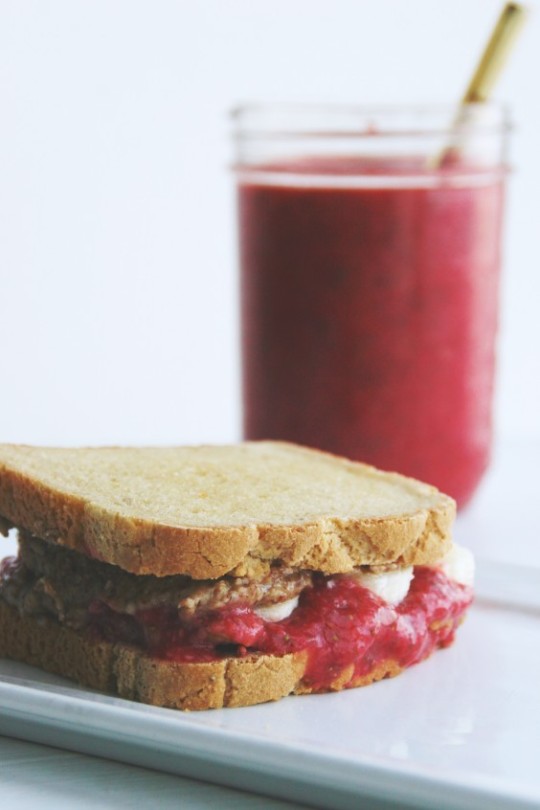
Photo: Days Like Laura
“We didn’t turn up to a renowned Greatist recipe roundup just to have sandwiches thrown in our faces!”
We know, we know. But hear us out. This one’s a special take on PB&J that pushes all the right buttons.
Swap in almond butter, add some homemade strawberry chia jam, and you have yourself a bomb-ass concoction.
For a quicker recipe, you can also just add some sliced strawberries. The whole-grain bread and strawberries offer a great dose of heart-healthy fiber, the almond butter is rich in protein, and the banana’s packed with potassium.
How can you stay mad at us with all that potassium?
5. One-ingredient banana ice cream

Photo: Garlic Matters
Ice cream doesn’t have to be unhealthy — as long as you define “ice cream” pretty loosely.
Simply peel a few bananas, stick them in the freezer, and let them hang out for a few hours or until they’re solid. Put the frozen ’nanas in the bowl of a food processor and process them until smooth.
Finally, add your choice of mix-ins (if you like). Dark chocolate chips, diced strawberries, and a PB swirl are Greatist favorites.
6. Papaya punch smoothie

Photo: Exploring Healthy Foods
Idina Menzel, eat your heart out — this fruit, veggie, ice, and chia smoothie is the real delivery of frozen perfection.
It’s loaded with papaya, a tropical fruit that has tons of flavor and fiber. Papaya is also relatively low in sugar compared to other fruits, with just 11.3 grams per cup.
Papaya’s got a brand new bag.
7. Summer fruit spring rolls

Photo: Bigger Bolder Baking
There’s no way you’d expect these flavors from spring rolls. Who knew they could taste this sweet?
This inventive take on the sushi restaurant favorite fills classic rice wraps with fresh fruit for a simple, slightly sweet (and super fun) snack.
8. Strawberry Nutella bruschetta
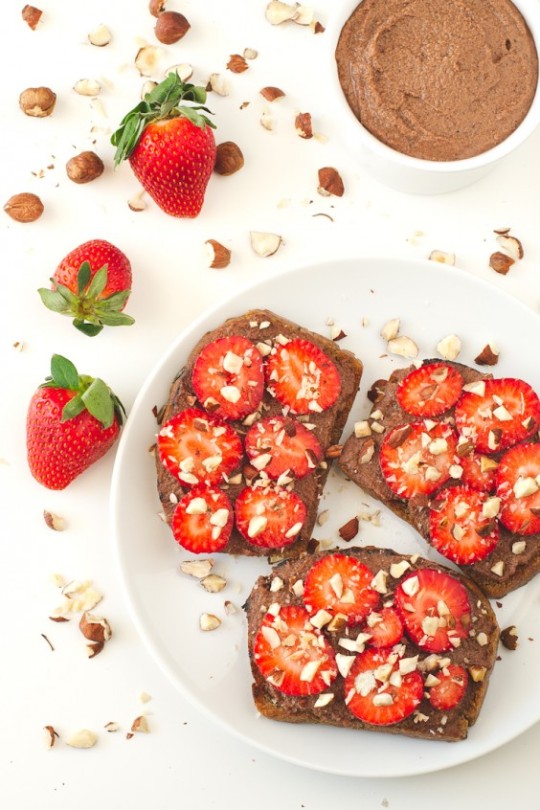
Photo: Simple Vegan Blog
It’s a recipe that rhymes satisfyingly and tastes even better than it sounds.
Strawberries plus Nutella is a classic combo. Just add a slice of toasted whole-grain bread for a fiber-rich, filling snack. You can also sprinkle some chia seeds, honey, or coconut flakes on top for an added flavor boost!
9. Lemon raspberry cheesecake ice pops
Photo: Simply Recipes
The word “cheesecake” might make this recipe sound like a rich dessert, but it clocks in at half the calories of the classic cheesecake. Plus, you can hold it on a stick, so it might already be beating the original.
In this version, “cheesecake” is actually just the sweetened lemony Greek yogurt mixture that gives these pops a creamy texture.
10. Frozen yogurt bites
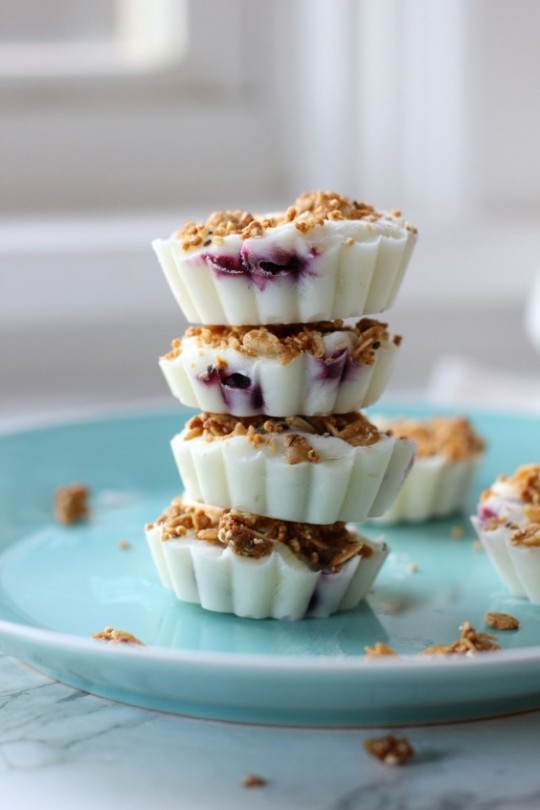
Photo: I Heart Vegetables
This recipe is an awesome way to get creative with some items you probably already have in your kitchen.
Freeze some Greek yogurt with granola, pop whatever fruit you like on top, and boom! It’s a cute breakfast treat for the next morning!
11. Spicy fruit salad

Photo: Minimalist Baker
If you’ve ever thought of fruit salad as boring, you have to give this recipe a try (you’re also wrong — sorry).
Sprinkle some lime juice and chili powder on top of your favorite fruity mixture for an added kick in flavor and heat.
Can’t take the heat? You don’t have to get out of the kitchen — just try cinnamon instead.
12. Two-ingredient banana chocolate chip ice cream bites

Photo: The Baker Mama
Two of our favorite foods take center stage in this recipe: bananas and chocolate chips. You can’t go wrong here.
Blend up some frozen bananas in a food processor, and then dump in some chips. That’s it. These guys store for 2 to 3 months in the freezer, so feel free to make a giant batch to dip into whenever you feel the munchies.
13. Frozen grapes

Photo: Zen and Spice
This is so simple it barely qualifies as a recipe — it’s more of a recommendation, because, well, these bang.
Buckle up, because here are the steps:
Remove grapes from vine.
Freeze.
Get snackin’.
This easy, naturally sweetened treat is perfect to keep in the freezer for when that sweet tooth comes calling.
14. Vegan blueberry oat bars
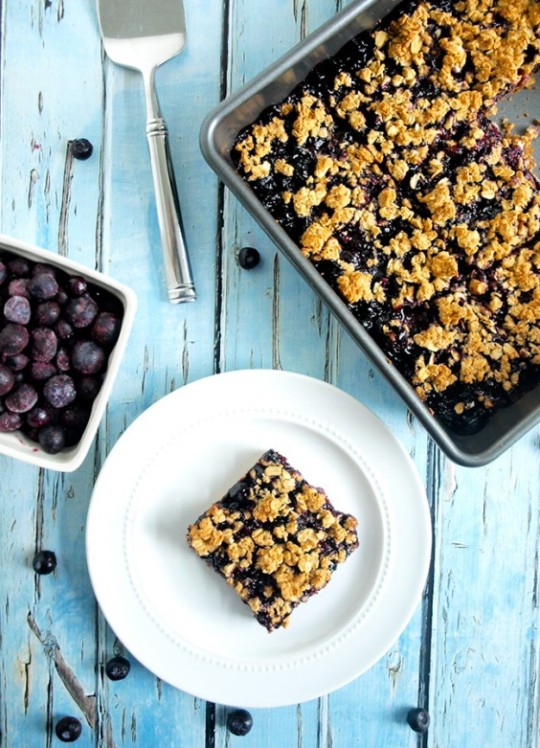
Photo: Happy Healthy Mama
These breakfast-on-the-go bars are a healthier twist on blueberry cobbler.
The blogger uses just blueberries, but feel free to throw in some strawberries, raspberries, or blackberries for a mixed-berry version.
15. Pineapple and blueberry fruit salad
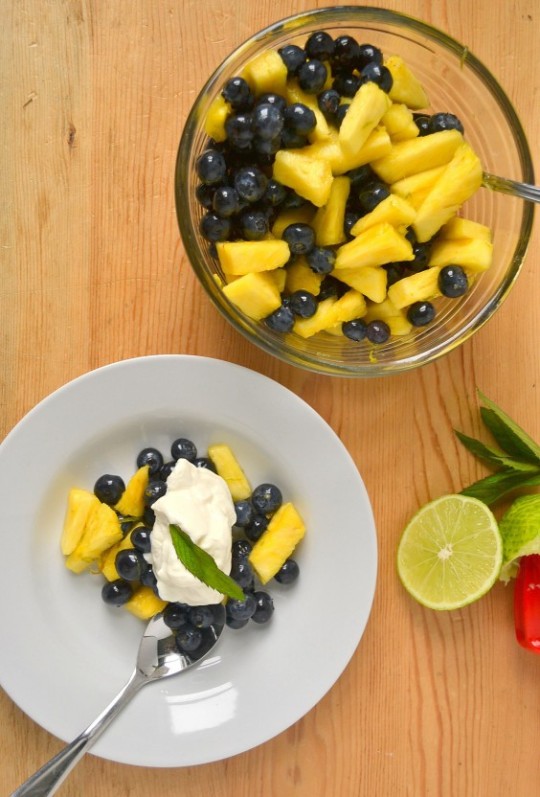
Photo: Food Doodles
The key to this recipe is what goes on top (like a great hairdo or a zany hat).
Pineapples and blueberries are awesome, but when you add some lime zest, lime juice, honey, and Greek yogurt on top, you get a next-level treat that’s creamy, zingy, and healthy in equal measure.
16. Cherries Jubilee chocolate chia seed pudding

Photo: Real Food Whole Life
Cherries Jubilee is a classic dessert, but it isn’t exactly the healthiest snack.
This recipe keeps the awesome cherry flavor but adds some healthier substitutes (like cacao) and nutritional bonuses (like chia seeds). Plus, this looks great in a mason jar, so you can seem fancy at all times.
17. Yogurt breakfast parfait with plum compote

Photo: Cake and Whisky
This fall-inspired breakfast has an awesome combination of some pretty underrated fruits and nuts.
Plums, blackberries, and hazelnuts shine in the classic parfait-style snack. And if you’re really in the fall mood, try sprinkling some pumpkin pie spice on top (because you know full well it’s pumpkin spice everything season).
18. Fruit sushi (frushi)
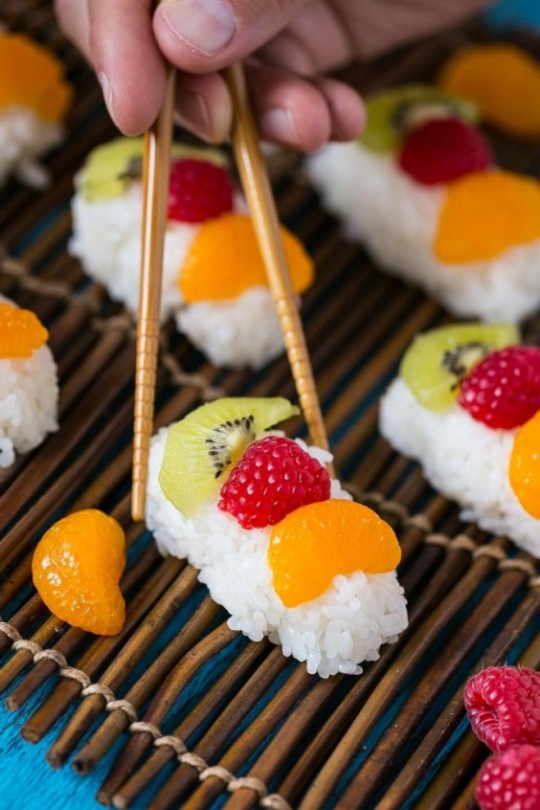
Photo: Dinner at the Zoo
Time to play with your food! (Also, “frushi” is an excellent name. You might want to consider it for a pet in the future.)
This is a super fun snack recipe. Put some sliced kiwi, oranges, and raspberries on top of sushi rice for a fancy treat.
Of course, feel free to improvise — sliced strawberries, mango, or apple would also make a tantalizing topper.
19. Melon salad with chili and mint
Photo: Simply Recipes
No matter your age, making spherical chunks of melon is always a baller move (not sorry — that was great) and a lot of fun to boot. It rolls up just like ice cream.
Chili and mint make this a sophisticated, interesting array of flavors — you’ll never think about melon the same way again.
20. Breakfast yogurt pops
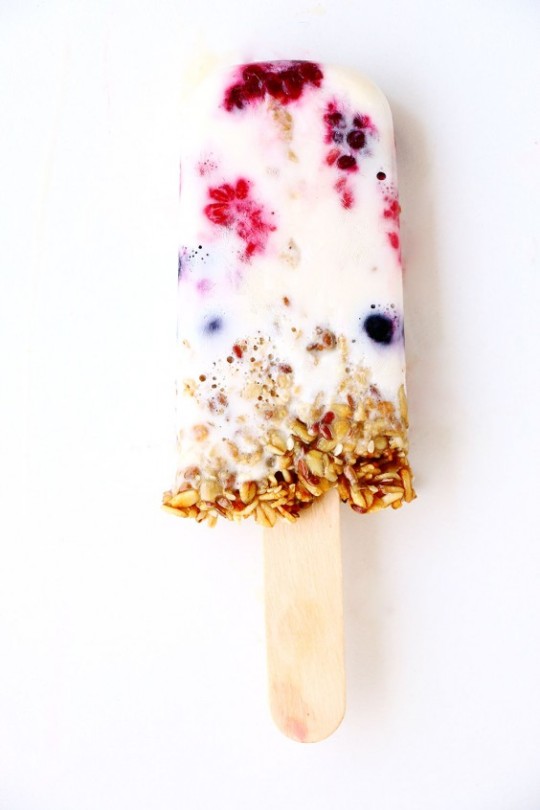
Photo: I Heart Naptime
Tired of your same old yogurt-and-granola breakfast? Try changing up the shape. Yes, it all ends up in the same place, but shapes are fun and ice pops more so.
This recipe takes the classic combo and freezes it into a (very ’grammable) ice pop.
Just make sure to prep these the night before, since they need to sit in the freezer for at least 4 hours.
21. Blueberry coconut protein balls

Photo: One Broad’s Journey
Making a ton of these little protein balls is the perfect way to meal-prep some snacks for the week.
The secret ingredient here is lemon. The combo of lemon juice and lemon zest adds a burst of flavor to the blueberry-coconut one-two punch.
Pop one of these in your cakehole for a kick-ass start to the day.
22. Sesame oat square bars with pear compote
Photo: Cooking Melangery
Oat bars are a great way to save some time in your week — and these are on the fancier side. Make a bunch on Sunday so you’ll be able to grab them on the go during your busy workweek.
Coconut oil binds all the oats together — there’s not an egg in sight, which makes these bars super-duper vegan-friendly.
The recipe includes a homemade pear compote that will satisfy any fruit lover’s craving.
23. Chewy raspberry apple granola bars

Photo: Amy’s Healthy Baking
Granola bars are far from boring when you make them at home. You can customize the flavors however you want, and there’s none of the processed ingredients and preservatives you’d find in store-bought options.
This simple version has just seven ingredients like milk, honey, oil, and cinnamon. Raspberries stand out and do jazz hands as the vibrant, delicious star of the show.
Fruits still have a lot of sugar
While fruits are amazing and can boast a huge range of vital vitamins and minerals, they come with a heavy hit of fructose — a natural sugar, but still a sugar.
If you’re on a sugar-restricted diet or have a condition that can impact your blood sugar levels, such as diabetes, it’s best to eat fruit in moderation and be selective about the fruit you eat.
Some fruits are better than others for people with diabetes — we rounded them up here.
Savory
A mix of flavors is the mark of enlightened kitchen work, so try to switch up your fruit game entirely and get creative.
24. Grilled fruit pizza

Photo: The Chunky Chef
Oh, boy… is pizza not just bae? Well, we’re willing to wager that you haven’t had one with fruit and honey as a topping before. (If you’re one of those who falls on the angrier side of the pineapple-on-pizza debate, this one might not be for you. Or maybe it’ll convert you.)
Just grill up some pizza dough, naan, or tortilla and sprinkle your favorite fruits on top.
25. Strawberry and goat cheese bruschetta

Photo: Homemade Hooplah
We’d eat goat cheese with pretty much anything, but it’s especially good with fruit. The creamy saltiness offsets the sweetness of many fruits beautifully. But strawberries hold the starring role here.
This bruschetta recipe features the gooey combo with a balsamic glaze on top that really brings out the strawberryishness (definitely a word) of the strawberries.
26. Peach quinoa tabbouleh
Photo: Jo Eats
Peaches and quinoa might not seem like a match made in heaven, but this sweet and salty Middle Eastern-inspired dish has other ideas.
Honey, mint, and parsley dance around the peach flavors, adding all kinds of busy mouth sensations. Even as a side or a standalone snack, this intriguing tabbouleh stands all on its own.
27. Honey-lemon toast with figs and pistachios

Photo: Ambitious Kitchen
Getting creative with toast is all the rage these days (thanks, avo toast!).
This honey-fig version is the perfect savory way to eat your fruit. With ricotta slathered on the base, stopping your snack at a single slice is the most difficult thing about this recipe.
28. Creamy cheese fruit pizza

Photo: The Frugal Foodie Mama
Fruity pizza: round two. (Wait, how is there more than one? Where the f*ck are all these fruit pizzas coming from?)
This one features peaches and blackberries, but feel free to make your own version with any fruit-cheese-dough combo.
Get as creative as your brain wants — they broke the seal with pineapples many moons ago. This is just the natural consequence.
29. Mango, avocado, and fresh cilantro salsa
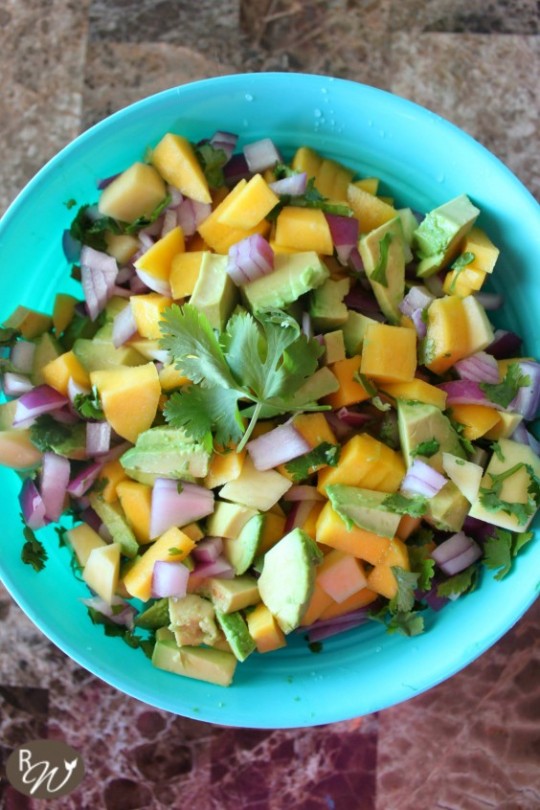
Photo: The Frugal Foodie Mama
You’ve heard that it takes two to tango — well, it can take two fruits to salsa. And, yes, avocado is a fruit.
This two-fruit salsa (yes, avocado is a fruit) is a way to give sweet flavors a savory twist when it’s served alongside classic tortilla chips.
Avocados are brimming with healthy monounsaturated fat and tons of vitamins, including vitamins E and B6.
30. Fig and prosciutto crostini

Photo: Mama’s Gotta Bake
Fresh figs — does it get any better?
Well, when you wrap a fresh fig in a slice of salty prosciutto and stick it on top of some toasted bread, you’ll learn that there’s more to the already mighty fig than meets the eye.
31. Melon, prosciutto, and mozzarella skewers

Photo: The Comfort of Cooking
Here’s another awesome salty-sweet combo (because savory doesn’t mean you need to kick all the sweetness out).
Prosciutto and melon is a classic duo. Add fresh mozzarella, put it on a stick, and things get seriously tasty.
Takeaway
Fruit wears many disguises, and almost all of them are delicious (when put together right).
Whether you’re in the mood for sweetness or a broader experience for your taste buds, you don’t need added sugars. You can use the natural sugars in fruits to bolster the flavor of your meal and take advantage of their natural goodness.
Had your fill of pizzas made of fruit? Fine, here are some desserts made from vegetables (and if you think carrot cake is the limit, you are very much mistaken).
from Greatist Health RSS Feed https://ift.tt/2HZWbKL 31 Healthy Snacks for When You Love Fruit but Have a Sweet Tooth Greatist Health RSS Feed from HEALTH BUZZ https://ift.tt/327t1kl
0 notes
Text
Fange Venture Deeper Into The Dankness With Caustic Third Album
~By Clément Helvete~

Originating from Rennes (Bretagne), French noisemakers FANGE managed to become a force to be reckoned with in just a handful of years, and one of France’s most recognizable band, both sonically and visually. Fange expertly blends influences to deliver a downpour of decibels. By combining sludge and crust punk influenced riffs with unsettling electronic/noise parts and loads of feedback, the band created a very personal sound from their very first release. The themes have been pretty consistent throughout the band’s six-year run, i.e. complementing dark, grueling music with filthy looking artwork and creepy-crawly thingies.
Fange’s new album, 'Punir' (2019), is the successor to 2016’s Purge and 2017’s Pourrissoir. It was released on Throatruiner records, Fange’s long-time partner in crime and vocalist Matthias Jungbluth’s brainchild. Recorded and mixed by Cyrille Gachet (Year of No Light, Chaos Echoes) and mastered by Brad Boatright (Yob, Nails) Punir is a 37-minute exercise in mind-blowing brutality.
The artwork was done by Benjamin Moreau, guitarist and founder of the band, and bass player of the late occult doom combo Huata. It is no surprise that Fange decided to keep full creative control of the artwork as it was established as an essential aspect of the band’s identity from the very beginning. The overall color tones stay in the vein of the previous two releases (red and black), there is still plenty of guts and gore to go around, and the result is just as eye-catching and intriguing as every single cover put out by the band. The use of bold black lines, which has become a staple of Benjamin Moreau’s visual style, and the cover’s hand drawn feeling announces that we’re about to listen to some ferocious and unbridled music. I personally own the LP version, and the whole thing is truly gorgeous. Moreover, the back of the LP sleeve features a wall of Sunn amps and cabs that will make gearheads shudder in anticipation.
Punir by FANGE
If you’re already familiar with Fange’s discography, the very first thing you’ll notice with Punir is that the band’s sound has changed a bit and has become even more abysmal. Imagine Pourrissoir on steroids. This change comes primarily from the presence of a bass player, namely Antoine Perron, for the very first time on a Fange record. Apparently the band didn’t want this new asset to go to waste and decided to put a serious emphasis on the lows. If you’re listening to Punir with bassy headphones or speakers, it might actually get tiring after a while. On the other hand, Fange isn’t exactly known for pulling their punches, so it’s fair to assume that it was a deliberate choice in order to add to the oppressive feeling of Punir.
The album starts off with "Ceinturon." After a short intro riff, the guitar launches into a Swedish buzzsaw-infused, death metal riff accompanied by a thundering rhythm section and vocals as thick and harsh as volcano smoke. The whole track is an ode to savagery and a great introduction to what is to come. The guitars crush everything that stands in their way, while Matthias alternates between beastly screams and haunting vocals. Alexandre Jadi’s first album appearance as Fange’s drummer is amazingly powerful, fast and relentless, yet subtle when necessary. Rarely have I been so glad to not be drum kit, because this one is taking a severe beating. The whole album flows really well and takes you through a mind-bending journey like a bad acid trip. Punir can be described as a controlled blend of crushing violence with hints of finesse, or as the band put it “ignorant music for the educated man.”
Fange has no problem going from eerie soundscapes to pummeling parts completely seamlessly. Nothing ever feels clumsy or forced, which can be challenging when combining such diverse influences. The variations in the vocal ranges are always spot on and add a unique feel to the songs. The guitar work is actually quite thoughtful. Dissonant melodies are used to create atmosphere and add contrast, thus highlighting the heavy and aggressive parts. The bass provides a sturdy foundation to the tracks and is a welcome addition to the band’s sound. The icing on the cake is the incredibly rich drumming style of Alexandre Jadi. Words really cannot do it justice, just listen to Punir and you’ll understand. Every single member of Fange is an essential cog in a well-oiled machine, which results in a very well balanced and solid album.

Photo by Gael Hervé c/o The Heavy Chronicles
The influence of early Swedish death metal is a lot more prominent on Punir than it was on previous albums (apart for the heavy use of the Boss HM-2 distortion pedal, which has been Fange’s signature sound from the very beginning), which is a great thing in my book. I was very curious to hear what direction Fange would take after their previous album, as it is one of these bands that manage to evolve in a completely logical, yet surprising, way with each release. Punir doesn’t disappoint, and it is quite obvious that Fange is very comfortable with its identity and confident with its sound. The band retains its noisy/electronic tendencies ("Opinel," "Maintien de l’Ordre," "Second Soleil") and sludgy, D-beat roots ("Chien de Sang," "Il Reconnaîtra les Siens") while adding new influences and perfecting its craft.
Punir stays under the 40-minute mark as it was clearly not intended to be a long, dragging experience but more as an extremely intense, short burst of energy. Overall this album is undeniably a pleasant surprise and a great success. Oddly enough, I would even say that it might be the band’s most accessible release to this day, although Purge remains my personal favorite. A lot more mature and controlled than its predecessor, Punir is the rightful continuation of Fange’s discography and a well-crafted piece to add to the band’s monument. I wouldn’t be surprised to see Punir rear its ugly head around the corner when comes the time of 2019 album of the year lists.
Follow The Band
Get Their Music
0 notes
Text
33 Gluten Free Christmas Cookie Recipes for the Holidays
New blog post! The holidays are here, and 'tis definitely the season for Christmas cookies! To celebrate National Christmas Cookie Day (which is on December 4, in case you needed an excuse to enjoy some delicious cookies!), I thought I'd round up some of the best gluten free cookies around the blogosphere.
Whether you're looking for vegan sugar cookies, the best gluten free gingerbread cookie recipe or just cookies that everyone will love, you've come to right place! So let's stop talking and start drooling over these 33 gluten free Christmas cookie recipes...
1. Chocolate Cookies with Dark Chocolate Chips (Vegan) - Delicious Everyday
'Cause is there ever such a thing as too much chocolate? I don't think so!
2. Gingerbread Cookies with Sea Salt Caramel Rum Raisin Filling (Vegan) - E. A. Stewart
If this filling tastes anywhere near as good as it looks, I know I'd be eating these cookies by the handful!
3. Fudgy Chocolate Crinkle Cookies - Faithfully Gluten Free
Cookies that are crispy on the outside, soft on the inside and packed with lots of chocolatey flavor? Yes, please!
4. Dye Free Coconut Rainbow Cookies (Vegan) - Casey the College Celiac
If you want to enjoy an extra colorful Christmas treat, look no further than my rainbow cookies! These are dyed naturally with superfoods like turmeric, spirulina and mashed berries. Plus, they're free of refined sugar and taste just as delicious for breakfast as they do dessert.
5. Thumbprint Caramel Pecan Turtle Cookies (Sugar Free) - Wholesome Yum
I'm a sucker for caramel with nuts, so these cookies are high on my Christmas baking to-do list.
6. Easy Ginger Cookies with Candied Ginger - Fearless Dining
Soft, chewy cookies that are also bursting with ginger flavor? I'll take two trays, please!
7. Easy Holiday Cut Out Cookies (Grain Free) - The Real Food RN
Who says you can't enjoy some deliiiicious Christmas cookies on a grain-free diet?
8. Chocolate Chip Bacon Cookies (Dairy Free Option) - Raia's Recipes
If you want to give chocolate chip cookies a unique twist (or you just realllly like bacon), this creative gluten free cookie recipe is your Christmas miracle!
9. Gingerbread Men Cookies (Dairy Free, Refined Sugar Free) - Celiac Mama
These gingerbread cookies almost look too good to eat! Keyword: almost...
10. Flourless S’mores Peanut Butter Cookies - The Monday Box
S'mores just got an upgrade.
11. Gluten-Free Red Velvet Chocolate Chip Cookies (Dairy-Free Option) - Mama Knows Gluten Free
Gluten free chocolate chip cookies + red velvet cake = one heck of a tasty holiday treat...
12. Spritz Cookies (Dairy Free, Vegan Option) - Flippin' Delicious
Three words: simple and scrumptious!
13. Flourless Peanut Butter Cookies with Dark Chocolate Chips (Dairy Free) - The Rising Spoon
If you love peanut butter, prepare to meet the gluten free cookie recipe of your dreams.
14. Lofthouse-Style Soft Frosted Sugar Cookies (Vegan) - Strength and Sunshine
Anyone else really wishing you could dive head-first into that frosting?!?
15. Oatmeal Cranberry Chocolate Chip Cookies (Dairy Free Option) - My Gluten-Free Kitchen
Chocolate chip cookies just got a crunchy, chewy upgrade!
16. Rose Shortbread Cookies (Grain Free) - Savory Lotus
Who would've thunk that roses would be just as pretty on cookies as they are in your garden?!?
17. Flourless Chocolate Peppermint Cookies (Paleo) - Hungry Hobby
Chocolate and peppermint is always a winning combo during the holidays, and these cookies are no exception.
18. Sugar Cookies (Dairy Free) - Allergy Free Alaska
This Christmas classic just an allergy friendly makeover...
19. Pumpkin Chai Snickerdoodles (Dairy Free Option) - MI Gluten Free Gal
Pumpkin + chai + snickerdoodles? If there's another more "fall-y" cookie recipe out there, I've yet to find it!
20. Jam-Filled Thumbprint Cookies (Grain Free, Vegan) - Delicious Obsessions
These short-bread like cookies get a burst of bright, fruity flavors from blackberry, strawberry and blood orange jam.
21. Russian Tea Cookies, AKA Snowballs - Grain Changer
Now THIS is my kind of snowball!
22. Christmas Tree Spiced Biscuits (Dairy Free) - Honest Mum
Talk about a gluten free cookie recipe that's just as gorgeous as it is tasty!
23. Perfect Peppermint Cookies (Paleo, Vegan) - Texanerin Baking
No one will ever guess that these cookies are paleo, dairy free and egg free...
24. 3-Ingredient Pumpkin Cookies (Vegan) - Casey the College Celiac
If you need to have Christmas cookies baked by, like, yesterday, this super simple pumpkin cookie recipe is exactly what you need! It uses Namaste's Organic Pumpkin Baking Mix, along with water and aquafaba (the liquid from canned chickpeas), and the cookies turn out crispy on the outside and chewy on the inside. Droooool....
25. Mantecado and Spanish Polvorón (Grain Free) - Oh, The Things We'll Make
I'd never heard of these Spanish cookies before, but I love how soft and crumbly they look! In the spirit of my college Spanish classes, these grain free cookies look "muy delicioso."
26. Stained Glass Cookies - Noshtastic
The best thing about these gorgeous cookies? They're surprisingly easy to make!
27. Holiday Thin Mints (Vegan) - Gluten Free with Emily
Thin mints were always my favorite Girl Scout cookie, so this cookie is really calling my name...
28. Chocolate Pepper Cookies - Masala Herb
I never would've thought to combine chocolate with peppercorns, but I think this gluten free cookie would definitely win me over!
29. Peppermint Macarons with Chocolate Ganache (Dairy Free) - What the Fork Food Blog
The holidays just got a whoooole lot tastier with these homemade macarons...
30. Gingerbread Men Cookies (Egg Free) - Dishing Delish
These gluten free gingerbread men cookies are as classic as they get...except they're gluten free and egg free, so even more people can enjoy them.
31. White Chocolate Macadamia Cookies - Gluten Free Palate
I rarely splurge on gluten free macadamia nuts, but the next time I do, these cookies will definitely be high on my to-do list!
32. Sugar Cookies (Vegan) - Rhian's Recipes
What really makes these vegan sugar cookies stand out is the homemade frosting. Soaked and blended cashew nuts make up most of the frosting, and it's dyed naturally with superfoods like beetroot and spirulina!
33. Chocolate Peppermint Dipped Meringues - Boulder Locavore
These holiday treats are light, crunchy and packed with lots of Christmas cheer!
Happy cookie time!
I don't know about you, but making Christmas cookies with my family during the holidays is one of my favorite winter activities. When I was diagnosed with celiac disease five years ago, I worried about not being able to enjoy that delicious tradition - but, as all of these yummy gluten free cookie recipes show, you can definitely enjoy Christmas cookies even with dietary restrictions. And who knows? You might end up having the same experience I did and find a gluten free cookie recipe that you like even better than the wheat-filled treats you used to eat! Happy holidays, everyone! Let me know which one of these gluten free Christmas cookies sound the most delicious to you in the comments... via Blogger https://ift.tt/2BLNU7I
0 notes
Text
Mesh WiFi vs Router: Which One Should You Choose
If you’ve been paying any attention to the world of routers over the past two years or so, you may have noticed a new product category that’s quickly started to dominate the manufacturers’ sales cycle: mesh routers. But what are mesh routers, how do they work, and how do they compare against traditional routing solutions? Read on in our guide to find out!
Traditional Routers
Since their introduction back in 1999, consumer-grade wireless routers haven’t really evolved much beyond their basic function. Sure, there’s been a number of significant upgrades to their power, range, reliability and features, but other than that the core structure of what makes a wireless router remains functionally the same as it did 19 years ago. In essence (without getting too bogged down in the technical details), a router works like this: a hardline Ethernet cable is plugged into the back of the unit. The router then takes the signal from that line and broadcasts it out via several antennas placed around the unit over two distinct frequencies, either 2.4GHz or 5GHz (similar to what made wireless landline telephones work back in the 90’s). The distinction you see on the router itself in regards to the radio technology (802.11b/g/n) refers to the transmission protocol, while the rating (AC1900 vs. AC5300, etc), refers to the amount of bandwidth the router is capable of pumping out to multiple devices at once. Speaking of multiple devices, a more recent innovation to traditional routers is the inclusion of a feature known as MU-MIMO, short for Multiple User, Multiple-In Multiple-Out. In so many words this means that unlike a traditional router which streams data packets to every device hooked up to the network in a series of periodic bursts (think of a machine gun strapped to a carousel with one device at each corner), MU-MIMO routers can seamlessly split their signal and broadcast packets simultaneously to every device on the network without any interruptions. The main drawback of traditional routers is for all their fancy technology, they are still ultimately limited by the size of the antennas on each side. While most consumer-grade routers under $300 are generally powerful enough to handle the needs of homes 1,500 square feet or smaller, beyond that range (or in homes with basements/third floors/big backyards), that’s where the signal power starts to drop off. That’s because for all the creative ways that router manufacturers have tried to boost the signal in their routers, ultimately they’ll always be limited by the real world use cases of how we actually live and the way that devices fit into our lives. Especially since the rise of tablets and smartphones, people like to browse from every corner of their home instead of just from a single home office (as we did when wireless router technology first took off). This puts walls, doors, floors, ceilings, and even thick layers of concrete (in the case of basement browsing) in the way of the signal, which can be a difficult obstacle to get around for traditional router setups. And while the 2.4GHz spectrum is better at getting through walls than 5GHz, its speed limitations make it a less desirable option for gamers, streamers, and downloaders who want to roam freely without worrying about whether the signal is going to drop out in the middle of their usage. So how have router manufacturers attempted to solve this problem?
Range Extenders and Repeaters
The first way that router manufacturers attempted to get around the range problem were with devices known as wireless range extenders (also known as “repeaters” in some cases). And while extenders are a decent band-aid to the wound of having a large home with a small router, the headaches they can cause often aren’t worth the cost of buying them and setting them up. A range extender/repeater works exactly as the name advertises: it extends, or “repeats” the signal sent out by your router and leapfrogs it to other parts of your home. The problem with this approach, however, is that because the extender has to have its own network in order to repeat the signal users need to manually switch between the regular router and the repeater every time they drift out of range of the original base station. With devices like the iPhone dominating the smartphone market thanks to their simplicity and ease of use compared to Android, the idea of expecting users to manually switch anything over in order to get the full experience really feels like too much to ask in 2018. Also, depending on the brand of extender or repeater you might experience significant slowdowns from what you would get on the base station due to the fact that all wireless signals transmit on what’s known as a “half-duplex” system. Not only that, but often extenders are more difficult to set up and configure correctly for non-tech savvy users, and this can prove to be especially difficult and convoluted if the brand of your router and your extender differ at all.
Mesh Networking Systems
Finally, enter mesh networking systems. Mesh networking looks to solve many of the issues present with single base station routers as well as routers with extenders attached thanks to several clever innovations that spent years in development before they hit the consumer market. Mesh networking works mostly the same to a router with a repeater in that an internet signal is taken from the landline and broadcast wirelessly throughout your home, but that’s about where the similarities end. Unlike a router/repeater combo, mesh systems communicate with each other over an ad-hoc system, which essentially replicates the base router across each mesh node (which can be as few as two stations, or an unlimited number if you want to just keep adding more and more depending on the size of your home). The primary benefit of this approach is both functional and aesthetic. On the functional side you end up with a single wireless network that works in every room of your house where a node is installed since every node communicates with its brothers the same way a traditional router would communicate with a repeater, basically covering your house in a fully lined “mesh” of connectivity. Mesh networking systems, unlike a router with a repeater, never lose signal strength, speed, or connection reliability as long as you have a mesh antenna installed in or around the room where you do most of your daily browsing. Aesthetically mesh networking systems are able to do away with the big gaudy antennas that are present on so many of today’s traditional routers, instead opting for much sleeker, design-first stations that would look good in anyone’s home. In the case of devices like the AmpliFi HD, the mesh nodes are actually just white antennas themselves that plug discreetly into any outlet of your home.
Mesh vs. Router
So with all the benefits of a mesh router system over a traditional router, why would you ever go back? Well, there’s a few compromises to be made. First, is cost. In almost every situation a mesh network will cost more than a standard wireless router because you’re physically buying more equipment than you would get with a single router (most basic mesh systems come with at least one base router along with 2-4 extra nodes), which increases the material cost. This can sometimes be offset by certain systems which let you buy a custom number of nodes to go along with your base station to better fit the layout and square footage of your home, but even still because mesh technology is the new kid on the block you can expect to pay a premium regardless of how many nodes you decide to include in your system. Next, there’s the issue of power. While most mesh systems are fine for daily browsing, streaming, and some types of gaming, they do suffer in heavier use case scenarios like more competitive gaming where ping and latency rule over consistent signals or raw bandwidth output. If you’re specifically trying to game on a router, we definitely recommend going with a powerful base station and just making sure your base station isn’t too far away from your gaming laptop or desktop (and who’s trying to get in a match of CS:GO in their backyard anyway, right?). If you already have a relatively powerful base router and are just trying to fix an annoying dead spot in your home, most repeaters/extenders worth their weight can be had for as little as $50. This makes them a much cheaper and more viable solution in the short term, and doesn’t require you to buy an entirely new system to get a system that can be argued that brings 90% of the same benefits. All that said, if you live in a large home, care about what an eyesore most routers can be, and want a system that will stand the test of the technology cycle, then a mesh networking system is definitely the way to go. Mesh networking is simple and intuitive to set up and provides a seamless user experience that traditional routers simply can’t match in this day and age.
Mesh WiFi vs Router: Which One Should You Choose was originally published to GadgetReview partner Christen da Costa
Mesh WiFi vs Router: Which One Should You Choose published first on http://www.gadgetreview.com/ Mesh WiFi vs Router: Which One Should You Choose posted first on http://www.gadgetreview.com/ Mesh WiFi vs Router: Which One Should You Choose published first on http://www.gadgetreview.com/
0 notes
Text
Mesh WiFi vs Router: Which One Should You Choose
If you’ve been paying any attention to the world of routers over the past two years or so, you may have noticed a new product category that’s quickly started to dominate the manufacturers’ sales cycle: mesh routers. But what are mesh routers, how do they work, and how do they compare against traditional routing solutions? Read on in our guide to find out!
Traditional Routers
Since their introduction back in 1999, consumer-grade wireless routers haven’t really evolved much beyond their basic function. Sure, there’s been a number of significant upgrades to their power, range, reliability and features, but other than that the core structure of what makes a wireless router remains functionally the same as it did 19 years ago. In essence (without getting too bogged down in the technical details), a router works like this: a hardline Ethernet cable is plugged into the back of the unit. The router then takes the signal from that line and broadcasts it out via several antennas placed around the unit over two distinct frequencies, either 2.4GHz or 5GHz (similar to what made wireless landline telephones work back in the 90’s). The distinction you see on the router itself in regards to the radio technology (802.11b/g/n) refers to the transmission protocol, while the rating (AC1900 vs. AC5300, etc), refers to the amount of bandwidth the router is capable of pumping out to multiple devices at once. Speaking of multiple devices, a more recent innovation to traditional routers is the inclusion of a feature known as MU-MIMO, short for Multiple User, Multiple-In Multiple-Out. In so many words this means that unlike a traditional router which streams data packets to every device hooked up to the network in a series of periodic bursts (think of a machine gun strapped to a carousel with one device at each corner), MU-MIMO routers can seamlessly split their signal and broadcast packets simultaneously to every device on the network without any interruptions. The main drawback of traditional routers is for all their fancy technology, they are still ultimately limited by the size of the antennas on each side. While most consumer-grade routers under $300 are generally powerful enough to handle the needs of homes 1,500 square feet or smaller, beyond that range (or in homes with basements/third floors/big backyards), that’s where the signal power starts to drop off. That’s because for all the creative ways that router manufacturers have tried to boost the signal in their routers, ultimately they’ll always be limited by the real world use cases of how we actually live and the way that devices fit into our lives. Especially since the rise of tablets and smartphones, people like to browse from every corner of their home instead of just from a single home office (as we did when wireless router technology first took off). This puts walls, doors, floors, ceilings, and even thick layers of concrete (in the case of basement browsing) in the way of the signal, which can be a difficult obstacle to get around for traditional router setups. And while the 2.4GHz spectrum is better at getting through walls than 5GHz, its speed limitations make it a less desirable option for gamers, streamers, and downloaders who want to roam freely without worrying about whether the signal is going to drop out in the middle of their usage. So how have router manufacturers attempted to solve this problem?
Range Extenders and Repeaters
The first way that router manufacturers attempted to get around the range problem were with devices known as wireless range extenders (also known as “repeaters” in some cases). And while extenders are a decent band-aid to the wound of having a large home with a small router, the headaches they can cause often aren’t worth the cost of buying them and setting them up. A range extender/repeater works exactly as the name advertises: it extends, or “repeats” the signal sent out by your router and leapfrogs it to other parts of your home. The problem with this approach, however, is that because the extender has to have its own network in order to repeat the signal users need to manually switch between the regular router and the repeater every time they drift out of range of the original base station. With devices like the iPhone dominating the smartphone market thanks to their simplicity and ease of use compared to Android, the idea of expecting users to manually switch anything over in order to get the full experience really feels like too much to ask in 2018. Also, depending on the brand of extender or repeater you might experience significant slowdowns from what you would get on the base station due to the fact that all wireless signals transmit on what’s known as a “half-duplex” system. Not only that, but often extenders are more difficult to set up and configure correctly for non-tech savvy users, and this can prove to be especially difficult and convoluted if the brand of your router and your extender differ at all.
Mesh Networking Systems
Finally, enter mesh networking systems. Mesh networking looks to solve many of the issues present with single base station routers as well as routers with extenders attached thanks to several clever innovations that spent years in development before they hit the consumer market. Mesh networking works mostly the same to a router with a repeater in that an internet signal is taken from the landline and broadcast wirelessly throughout your home, but that’s about where the similarities end. Unlike a router/repeater combo, mesh systems communicate with each other over an ad-hoc system, which essentially replicates the base router across each mesh node (which can be as few as two stations, or an unlimited number if you want to just keep adding more and more depending on the size of your home). The primary benefit of this approach is both functional and aesthetic. On the functional side you end up with a single wireless network that works in every room of your house where a node is installed since every node communicates with its brothers the same way a traditional router would communicate with a repeater, basically covering your house in a fully lined “mesh” of connectivity. Mesh networking systems, unlike a router with a repeater, never lose signal strength, speed, or connection reliability as long as you have a mesh antenna installed in or around the room where you do most of your daily browsing. Aesthetically mesh networking systems are able to do away with the big gaudy antennas that are present on so many of today’s traditional routers, instead opting for much sleeker, design-first stations that would look good in anyone’s home. In the case of devices like the AmpliFi HD, the mesh nodes are actually just white antennas themselves that plug discreetly into any outlet of your home.
Mesh vs. Router
So with all the benefits of a mesh router system over a traditional router, why would you ever go back? Well, there’s a few compromises to be made. First, is cost. In almost every situation a mesh network will cost more than a standard wireless router because you’re physically buying more equipment than you would get with a single router (most basic mesh systems come with at least one base router along with 2-4 extra nodes), which increases the material cost. This can sometimes be offset by certain systems which let you buy a custom number of nodes to go along with your base station to better fit the layout and square footage of your home, but even still because mesh technology is the new kid on the block you can expect to pay a premium regardless of how many nodes you decide to include in your system. Next, there’s the issue of power. While most mesh systems are fine for daily browsing, streaming, and some types of gaming, they do suffer in heavier use case scenarios like more competitive gaming where ping and latency rule over consistent signals or raw bandwidth output. If you’re specifically trying to game on a router, we definitely recommend going with a powerful base station and just making sure your base station isn’t too far away from your gaming laptop or desktop (and who’s trying to get in a match of CS:GO in their backyard anyway, right?). If you already have a relatively powerful base router and are just trying to fix an annoying dead spot in your home, most repeaters/extenders worth their weight can be had for as little as $50. This makes them a much cheaper and more viable solution in the short term, and doesn’t require you to buy an entirely new system to get a system that can be argued that brings 90% of the same benefits. All that said, if you live in a large home, care about what an eyesore most routers can be, and want a system that will stand the test of the technology cycle, then a mesh networking system is definitely the way to go. Mesh networking is simple and intuitive to set up and provides a seamless user experience that traditional routers simply can’t match in this day and age.
Mesh WiFi vs Router: Which One Should You Choose was originally published to GadgetReview partner Christen da Costa
Mesh WiFi vs Router: Which One Should You Choose published first on http://www.gadgetreview.com/ Mesh WiFi vs Router: Which One Should You Choose published first on http://www.gadgetreview.com/ Mesh WiFi vs Router: Which One Should You Choose posted first on http://www.gadgetreview.com/
0 notes
Text
Mesh WiFi vs Router: Which One Should You Choose
If you’ve been paying any attention to the world of routers over the past two years or so, you may have noticed a new product category that’s quickly started to dominate the manufacturers’ sales cycle: mesh routers. But what are mesh routers, how do they work, and how do they compare against traditional routing solutions? Read on in our guide to find out!
Traditional Routers
Since their introduction back in 1999, consumer-grade wireless routers haven’t really evolved much beyond their basic function. Sure, there’s been a number of significant upgrades to their power, range, reliability and features, but other than that the core structure of what makes a wireless router remains functionally the same as it did 19 years ago. In essence (without getting too bogged down in the technical details), a router works like this: a hardline Ethernet cable is plugged into the back of the unit. The router then takes the signal from that line and broadcasts it out via several antennas placed around the unit over two distinct frequencies, either 2.4GHz or 5GHz (similar to what made wireless landline telephones work back in the 90’s). The distinction you see on the router itself in regards to the radio technology (802.11b/g/n) refers to the transmission protocol, while the rating (AC1900 vs. AC5300, etc), refers to the amount of bandwidth the router is capable of pumping out to multiple devices at once. Speaking of multiple devices, a more recent innovation to traditional routers is the inclusion of a feature known as MU-MIMO, short for Multiple User, Multiple-In Multiple-Out. In so many words this means that unlike a traditional router which streams data packets to every device hooked up to the network in a series of periodic bursts (think of a machine gun strapped to a carousel with one device at each corner), MU-MIMO routers can seamlessly split their signal and broadcast packets simultaneously to every device on the network without any interruptions. The main drawback of traditional routers is for all their fancy technology, they are still ultimately limited by the size of the antennas on each side. While most consumer-grade routers under $300 are generally powerful enough to handle the needs of homes 1,500 square feet or smaller, beyond that range (or in homes with basements/third floors/big backyards), that’s where the signal power starts to drop off. That’s because for all the creative ways that router manufacturers have tried to boost the signal in their routers, ultimately they’ll always be limited by the real world use cases of how we actually live and the way that devices fit into our lives. Especially since the rise of tablets and smartphones, people like to browse from every corner of their home instead of just from a single home office (as we did when wireless router technology first took off). This puts walls, doors, floors, ceilings, and even thick layers of concrete (in the case of basement browsing) in the way of the signal, which can be a difficult obstacle to get around for traditional router setups. And while the 2.4GHz spectrum is better at getting through walls than 5GHz, its speed limitations make it a less desirable option for gamers, streamers, and downloaders who want to roam freely without worrying about whether the signal is going to drop out in the middle of their usage. So how have router manufacturers attempted to solve this problem?
Range Extenders and Repeaters
The first way that router manufacturers attempted to get around the range problem were with devices known as wireless range extenders (also known as “repeaters” in some cases). And while extenders are a decent band-aid to the wound of having a large home with a small router, the headaches they can cause often aren’t worth the cost of buying them and setting them up. A range extender/repeater works exactly as the name advertises: it extends, or “repeats” the signal sent out by your router and leapfrogs it to other parts of your home. The problem with this approach, however, is that because the extender has to have its own network in order to repeat the signal users need to manually switch between the regular router and the repeater every time they drift out of range of the original base station. With devices like the iPhone dominating the smartphone market thanks to their simplicity and ease of use compared to Android, the idea of expecting users to manually switch anything over in order to get the full experience really feels like too much to ask in 2018. Also, depending on the brand of extender or repeater you might experience significant slowdowns from what you would get on the base station due to the fact that all wireless signals transmit on what’s known as a “half-duplex” system. Not only that, but often extenders are more difficult to set up and configure correctly for non-tech savvy users, and this can prove to be especially difficult and convoluted if the brand of your router and your extender differ at all.
Mesh Networking Systems
Finally, enter mesh networking systems. Mesh networking looks to solve many of the issues present with single base station routers as well as routers with extenders attached thanks to several clever innovations that spent years in development before they hit the consumer market. Mesh networking works mostly the same to a router with a repeater in that an internet signal is taken from the landline and broadcast wirelessly throughout your home, but that’s about where the similarities end. Unlike a router/repeater combo, mesh systems communicate with each other over an ad-hoc system, which essentially replicates the base router across each mesh node (which can be as few as two stations, or an unlimited number if you want to just keep adding more and more depending on the size of your home). The primary benefit of this approach is both functional and aesthetic. On the functional side you end up with a single wireless network that works in every room of your house where a node is installed since every node communicates with its brothers the same way a traditional router would communicate with a repeater, basically covering your house in a fully lined “mesh” of connectivity. Mesh networking systems, unlike a router with a repeater, never lose signal strength, speed, or connection reliability as long as you have a mesh antenna installed in or around the room where you do most of your daily browsing. Aesthetically mesh networking systems are able to do away with the big gaudy antennas that are present on so many of today’s traditional routers, instead opting for much sleeker, design-first stations that would look good in anyone’s home. In the case of devices like the AmpliFi HD, the mesh nodes are actually just white antennas themselves that plug discreetly into any outlet of your home.
Mesh vs. Router
So with all the benefits of a mesh router system over a traditional router, why would you ever go back? Well, there’s a few compromises to be made. First, is cost. In almost every situation a mesh network will cost more than a standard wireless router because you’re physically buying more equipment than you would get with a single router (most basic mesh systems come with at least one base router along with 2-4 extra nodes), which increases the material cost. This can sometimes be offset by certain systems which let you buy a custom number of nodes to go along with your base station to better fit the layout and square footage of your home, but even still because mesh technology is the new kid on the block you can expect to pay a premium regardless of how many nodes you decide to include in your system. Next, there’s the issue of power. While most mesh systems are fine for daily browsing, streaming, and some types of gaming, they do suffer in heavier use case scenarios like more competitive gaming where ping and latency rule over consistent signals or raw bandwidth output. If you’re specifically trying to game on a router, we definitely recommend going with a powerful base station and just making sure your base station isn’t too far away from your gaming laptop or desktop (and who’s trying to get in a match of CS:GO in their backyard anyway, right?). If you already have a relatively powerful base router and are just trying to fix an annoying dead spot in your home, most repeaters/extenders worth their weight can be had for as little as $50. This makes them a much cheaper and more viable solution in the short term, and doesn’t require you to buy an entirely new system to get a system that can be argued that brings 90% of the same benefits. All that said, if you live in a large home, care about what an eyesore most routers can be, and want a system that will stand the test of the technology cycle, then a mesh networking system is definitely the way to go. Mesh networking is simple and intuitive to set up and provides a seamless user experience that traditional routers simply can’t match in this day and age.
Mesh WiFi vs Router: Which One Should You Choose was originally published to GadgetReview partner Christen da Costa
Mesh WiFi vs Router: Which One Should You Choose published first on http://www.gadgetreview.com/ Mesh WiFi vs Router: Which One Should You Choose published first on http://www.gadgetreview.com/ Mesh WiFi vs Router: Which One Should You Choose published first on http://www.gadgetreview.com/
0 notes
Text
Mesh WiFi vs Router: Which One Should You Choose
If you’ve been paying any attention to the world of routers over the past two years or so, you may have noticed a new product category that’s quickly started to dominate the manufacturers’ sales cycle: mesh routers. But what are mesh routers, how do they work, and how do they compare against traditional routing solutions? Read on in our guide to find out!
Traditional Routers
Since their introduction back in 1999, consumer-grade wireless routers haven’t really evolved much beyond their basic function. Sure, there’s been a number of significant upgrades to their power, range, reliability and features, but other than that the core structure of what makes a wireless router remains functionally the same as it did 19 years ago. In essence (without getting too bogged down in the technical details), a router works like this: a hardline Ethernet cable is plugged into the back of the unit. The router then takes the signal from that line and broadcasts it out via several antennas placed around the unit over two distinct frequencies, either 2.4GHz or 5GHz (similar to what made wireless landline telephones work back in the 90’s). The distinction you see on the router itself in regards to the radio technology (802.11b/g/n) refers to the transmission protocol, while the rating (AC1900 vs. AC5300, etc), refers to the amount of bandwidth the router is capable of pumping out to multiple devices at once. Speaking of multiple devices, a more recent innovation to traditional routers is the inclusion of a feature known as MU-MIMO, short for Multiple User, Multiple-In Multiple-Out. In so many words this means that unlike a traditional router which streams data packets to every device hooked up to the network in a series of periodic bursts (think of a machine gun strapped to a carousel with one device at each corner), MU-MIMO routers can seamlessly split their signal and broadcast packets simultaneously to every device on the network without any interruptions. The main drawback of traditional routers is for all their fancy technology, they are still ultimately limited by the size of the antennas on each side. While most consumer-grade routers under $300 are generally powerful enough to handle the needs of homes 1,500 square feet or smaller, beyond that range (or in homes with basements/third floors/big backyards), that’s where the signal power starts to drop off. That’s because for all the creative ways that router manufacturers have tried to boost the signal in their routers, ultimately they’ll always be limited by the real world use cases of how we actually live and the way that devices fit into our lives. Especially since the rise of tablets and smartphones, people like to browse from every corner of their home instead of just from a single home office (as we did when wireless router technology first took off). This puts walls, doors, floors, ceilings, and even thick layers of concrete (in the case of basement browsing) in the way of the signal, which can be a difficult obstacle to get around for traditional router setups. And while the 2.4GHz spectrum is better at getting through walls than 5GHz, its speed limitations make it a less desirable option for gamers, streamers, and downloaders who want to roam freely without worrying about whether the signal is going to drop out in the middle of their usage. So how have router manufacturers attempted to solve this problem?
Range Extenders and Repeaters
The first way that router manufacturers attempted to get around the range problem were with devices known as wireless range extenders (also known as “repeaters” in some cases). And while extenders are a decent band-aid to the wound of having a large home with a small router, the headaches they can cause often aren’t worth the cost of buying them and setting them up. A range extender/repeater works exactly as the name advertises: it extends, or “repeats” the signal sent out by your router and leapfrogs it to other parts of your home. The problem with this approach, however, is that because the extender has to have its own network in order to repeat the signal users need to manually switch between the regular router and the repeater every time they drift out of range of the original base station. With devices like the iPhone dominating the smartphone market thanks to their simplicity and ease of use compared to Android, the idea of expecting users to manually switch anything over in order to get the full experience really feels like too much to ask in 2018. Also, depending on the brand of extender or repeater you might experience significant slowdowns from what you would get on the base station due to the fact that all wireless signals transmit on what’s known as a “half-duplex” system. Not only that, but often extenders are more difficult to set up and configure correctly for non-tech savvy users, and this can prove to be especially difficult and convoluted if the brand of your router and your extender differ at all.
Mesh Networking Systems
Finally, enter mesh networking systems. Mesh networking looks to solve many of the issues present with single base station routers as well as routers with extenders attached thanks to several clever innovations that spent years in development before they hit the consumer market. Mesh networking works mostly the same to a router with a repeater in that an internet signal is taken from the landline and broadcast wirelessly throughout your home, but that’s about where the similarities end. Unlike a router/repeater combo, mesh systems communicate with each other over an ad-hoc system, which essentially replicates the base router across each mesh node (which can be as few as two stations, or an unlimited number if you want to just keep adding more and more depending on the size of your home). The primary benefit of this approach is both functional and aesthetic. On the functional side you end up with a single wireless network that works in every room of your house where a node is installed since every node communicates with its brothers the same way a traditional router would communicate with a repeater, basically covering your house in a fully lined “mesh” of connectivity. Mesh networking systems, unlike a router with a repeater, never lose signal strength, speed, or connection reliability as long as you have a mesh antenna installed in or around the room where you do most of your daily browsing. Aesthetically mesh networking systems are able to do away with the big gaudy antennas that are present on so many of today’s traditional routers, instead opting for much sleeker, design-first stations that would look good in anyone’s home. In the case of devices like the AmpliFi HD, the mesh nodes are actually just white antennas themselves that plug discreetly into any outlet of your home.
Mesh vs. Router
So with all the benefits of a mesh router system over a traditional router, why would you ever go back? Well, there’s a few compromises to be made. First, is cost. In almost every situation a mesh network will cost more than a standard wireless router because you’re physically buying more equipment than you would get with a single router (most basic mesh systems come with at least one base router along with 2-4 extra nodes), which increases the material cost. This can sometimes be offset by certain systems which let you buy a custom number of nodes to go along with your base station to better fit the layout and square footage of your home, but even still because mesh technology is the new kid on the block you can expect to pay a premium regardless of how many nodes you decide to include in your system. Next, there’s the issue of power. While most mesh systems are fine for daily browsing, streaming, and some types of gaming, they do suffer in heavier use case scenarios like more competitive gaming where ping and latency rule over consistent signals or raw bandwidth output. If you’re specifically trying to game on a router, we definitely recommend going with a powerful base station and just making sure your base station isn’t too far away from your gaming laptop or desktop (and who’s trying to get in a match of CS:GO in their backyard anyway, right?). If you already have a relatively powerful base router and are just trying to fix an annoying dead spot in your home, most repeaters/extenders worth their weight can be had for as little as $50. This makes them a much cheaper and more viable solution in the short term, and doesn’t require you to buy an entirely new system to get a system that can be argued that brings 90% of the same benefits. All that said, if you live in a large home, care about what an eyesore most routers can be, and want a system that will stand the test of the technology cycle, then a mesh networking system is definitely the way to go. Mesh networking is simple and intuitive to set up and provides a seamless user experience that traditional routers simply can’t match in this day and age.
Mesh WiFi vs Router: Which One Should You Choose was originally published to GadgetReview partner Christen da Costa
Mesh WiFi vs Router: Which One Should You Choose published first on http://www.gadgetreview.com/ Mesh WiFi vs Router: Which One Should You Choose posted first on http://www.gadgetreview.com/
0 notes
Text
Mesh WiFi vs Router: Which One Should You Choose
If you’ve been paying any attention to the world of routers over the past two years or so, you may have noticed a new product category that’s quickly started to dominate the manufacturers’ sales cycle: mesh routers. But what are mesh routers, how do they work, and how do they compare against traditional routing solutions? Read on in our guide to find out!
Traditional Routers
Since their introduction back in 1999, consumer-grade wireless routers haven’t really evolved much beyond their basic function. Sure, there’s been a number of significant upgrades to their power, range, reliability and features, but other than that the core structure of what makes a wireless router remains functionally the same as it did 19 years ago. In essence (without getting too bogged down in the technical details), a router works like this: a hardline Ethernet cable is plugged into the back of the unit. The router then takes the signal from that line and broadcasts it out via several antennas placed around the unit over two distinct frequencies, either 2.4GHz or 5GHz (similar to what made wireless landline telephones work back in the 90’s). The distinction you see on the router itself in regards to the radio technology (802.11b/g/n) refers to the transmission protocol, while the rating (AC1900 vs. AC5300, etc), refers to the amount of bandwidth the router is capable of pumping out to multiple devices at once. Speaking of multiple devices, a more recent innovation to traditional routers is the inclusion of a feature known as MU-MIMO, short for Multiple User, Multiple-In Multiple-Out. In so many words this means that unlike a traditional router which streams data packets to every device hooked up to the network in a series of periodic bursts (think of a machine gun strapped to a carousel with one device at each corner), MU-MIMO routers can seamlessly split their signal and broadcast packets simultaneously to every device on the network without any interruptions. The main drawback of traditional routers is for all their fancy technology, they are still ultimately limited by the size of the antennas on each side. While most consumer-grade routers under $300 are generally powerful enough to handle the needs of homes 1,500 square feet or smaller, beyond that range (or in homes with basements/third floors/big backyards), that’s where the signal power starts to drop off. That’s because for all the creative ways that router manufacturers have tried to boost the signal in their routers, ultimately they’ll always be limited by the real world use cases of how we actually live and the way that devices fit into our lives. Especially since the rise of tablets and smartphones, people like to browse from every corner of their home instead of just from a single home office (as we did when wireless router technology first took off). This puts walls, doors, floors, ceilings, and even thick layers of concrete (in the case of basement browsing) in the way of the signal, which can be a difficult obstacle to get around for traditional router setups. And while the 2.4GHz spectrum is better at getting through walls than 5GHz, its speed limitations make it a less desirable option for gamers, streamers, and downloaders who want to roam freely without worrying about whether the signal is going to drop out in the middle of their usage. So how have router manufacturers attempted to solve this problem?
Range Extenders and Repeaters
The first way that router manufacturers attempted to get around the range problem were with devices known as wireless range extenders (also known as “repeaters” in some cases). And while extenders are a decent band-aid to the wound of having a large home with a small router, the headaches they can cause often aren’t worth the cost of buying them and setting them up. A range extender/repeater works exactly as the name advertises: it extends, or “repeats” the signal sent out by your router and leapfrogs it to other parts of your home. The problem with this approach, however, is that because the extender has to have its own network in order to repeat the signal users need to manually switch between the regular router and the repeater every time they drift out of range of the original base station. With devices like the iPhone dominating the smartphone market thanks to their simplicity and ease of use compared to Android, the idea of expecting users to manually switch anything over in order to get the full experience really feels like too much to ask in 2018. Also, depending on the brand of extender or repeater you might experience significant slowdowns from what you would get on the base station due to the fact that all wireless signals transmit on what’s known as a “half-duplex” system. Not only that, but often extenders are more difficult to set up and configure correctly for non-tech savvy users, and this can prove to be especially difficult and convoluted if the brand of your router and your extender differ at all.
Mesh Networking Systems
Finally, enter mesh networking systems. Mesh networking looks to solve many of the issues present with single base station routers as well as routers with extenders attached thanks to several clever innovations that spent years in development before they hit the consumer market. Mesh networking works mostly the same to a router with a repeater in that an internet signal is taken from the landline and broadcast wirelessly throughout your home, but that’s about where the similarities end. Unlike a router/repeater combo, mesh systems communicate with each other over an ad-hoc system, which essentially replicates the base router across each mesh node (which can be as few as two stations, or an unlimited number if you want to just keep adding more and more depending on the size of your home). The primary benefit of this approach is both functional and aesthetic. On the functional side you end up with a single wireless network that works in every room of your house where a node is installed since every node communicates with its brothers the same way a traditional router would communicate with a repeater, basically covering your house in a fully lined “mesh” of connectivity. Mesh networking systems, unlike a router with a repeater, never lose signal strength, speed, or connection reliability as long as you have a mesh antenna installed in or around the room where you do most of your daily browsing. Aesthetically mesh networking systems are able to do away with the big gaudy antennas that are present on so many of today’s traditional routers, instead opting for much sleeker, design-first stations that would look good in anyone’s home. In the case of devices like the AmpliFi HD, the mesh nodes are actually just white antennas themselves that plug discreetly into any outlet of your home.
Mesh vs. Router
So with all the benefits of a mesh router system over a traditional router, why would you ever go back? Well, there’s a few compromises to be made. First, is cost. In almost every situation a mesh network will cost more than a standard wireless router because you’re physically buying more equipment than you would get with a single router (most basic mesh systems come with at least one base router along with 2-4 extra nodes), which increases the material cost. This can sometimes be offset by certain systems which let you buy a custom number of nodes to go along with your base station to better fit the layout and square footage of your home, but even still because mesh technology is the new kid on the block you can expect to pay a premium regardless of how many nodes you decide to include in your system. Next, there’s the issue of power. While most mesh systems are fine for daily browsing, streaming, and some types of gaming, they do suffer in heavier use case scenarios like more competitive gaming where ping and latency rule over consistent signals or raw bandwidth output. If you’re specifically trying to game on a router, we definitely recommend going with a powerful base station and just making sure your base station isn’t too far away from your gaming laptop or desktop (and who’s trying to get in a match of CS:GO in their backyard anyway, right?). If you already have a relatively powerful base router and are just trying to fix an annoying dead spot in your home, most repeaters/extenders worth their weight can be had for as little as $50. This makes them a much cheaper and more viable solution in the short term, and doesn’t require you to buy an entirely new system to get a system that can be argued that brings 90% of the same benefits. All that said, if you live in a large home, care about what an eyesore most routers can be, and want a system that will stand the test of the technology cycle, then a mesh networking system is definitely the way to go. Mesh networking is simple and intuitive to set up and provides a seamless user experience that traditional routers simply can’t match in this day and age.
Mesh WiFi vs Router: Which One Should You Choose was originally published to GadgetReview partner Christen da Costa
Mesh WiFi vs Router: Which One Should You Choose published first on http://www.gadgetreview.com/
0 notes
Text
Mesh WiFi vs Router: Which One Should You Choose
If you've been paying any attention to the world of routers over the past two years or so, you may have noticed a new product category that's quickly started to dominate the manufacturers' sales cycle: mesh routers. But what are mesh routers, how do they work, and how do they compare against traditional routing solutions? Read on in our guide to find out!
Traditional Routers
Since their introduction back in 1999, consumer-grade wireless routers haven't really evolved much beyond their basic function. Sure, there's been a number of significant upgrades to their power, range, reliability and features, but other than that the core structure of what makes a wireless router remains functionally the same as it did 19 years ago. In essence (without getting too bogged down in the technical details), a router works like this: a hardline Ethernet cable is plugged into the back of the unit. The router then takes the signal from that line and broadcasts it out via several antennas placed around the unit over two distinct frequencies, either 2.4GHz or 5GHz (similar to what made wireless landline telephones work back in the 90's). The distinction you see on the router itself in regards to the radio technology (802.11b/g/n) refers to the transmission protocol, while the rating (AC1900 vs. AC5300, etc), refers to the amount of bandwidth the router is capable of pumping out to multiple devices at once. Speaking of multiple devices, a more recent innovation to traditional routers is the inclusion of a feature known as MU-MIMO, short for Multiple User, Multiple-In Multiple-Out. In so many words this means that unlike a traditional router which streams data packets to every device hooked up to the network in a series of periodic bursts (think of a machine gun strapped to a carousel with one device at each corner), MU-MIMO routers can seamlessly split their signal and broadcast packets simultaneously to every device on the network without any interruptions. The main drawback of traditional routers is for all their fancy technology, they are still ultimately limited by the size of the antennas on each side. While most consumer-grade routers under $300 are generally powerful enough to handle the needs of homes 1,500 square feet or smaller, beyond that range (or in homes with basements/third floors/big backyards), that's where the signal power starts to drop off. That's because for all the creative ways that router manufacturers have tried to boost the signal in their routers, ultimately they'll always be limited by the real world use cases of how we actually live and the way that devices fit into our lives. Especially since the rise of tablets and smartphones, people like to browse from every corner of their home instead of just from a single home office (as we did when wireless router technology first took off). This puts walls, doors, floors, ceilings, and even thick layers of concrete (in the case of basement browsing) in the way of the signal, which can be a difficult obstacle to get around for traditional router setups. And while the 2.4GHz spectrum is better at getting through walls than 5GHz, its speed limitations make it a less desirable option for gamers, streamers, and downloaders who want to roam freely without worrying about whether the signal is going to drop out in the middle of their usage. So how have router manufacturers attempted to solve this problem?
Range Extenders and Repeaters
The first way that router manufacturers attempted to get around the range problem were with devices known as wireless range extenders (also known as "repeaters" in some cases). And while extenders are a decent band-aid to the wound of having a large home with a small router, the headaches they can cause often aren't worth the cost of buying them and setting them up. A range extender/repeater works exactly as the name advertises: it extends, or "repeats" the signal sent out by your router and leapfrogs it to other parts of your home. The problem with this approach, however, is that because the extender has to have its own network in order to repeat the signal users need to manually switch between the regular router and the repeater every time they drift out of range of the original base station. With devices like the iPhone dominating the smartphone market thanks to their simplicity and ease of use compared to Android, the idea of expecting users to manually switch anything over in order to get the full experience really feels like too much to ask in 2018. Also, depending on the brand of extender or repeater you might experience significant slowdowns from what you would get on the base station due to the fact that all wireless signals transmit on what's known as a "half-duplex" system. Not only that, but often extenders are more difficult to set up and configure correctly for non-tech savvy users, and this can prove to be especially difficult and convoluted if the brand of your router and your extender differ at all.
Mesh Networking Systems
Finally, enter mesh networking systems. Mesh networking looks to solve many of the issues present with single base station routers as well as routers with extenders attached thanks to several clever innovations that spent years in development before they hit the consumer market. Mesh networking works mostly the same to a router with a repeater in that an internet signal is taken from the landline and broadcast wirelessly throughout your home, but that's about where the similarities end. Unlike a router/repeater combo, mesh systems communicate with each other over an ad-hoc system, which essentially replicates the base router across each mesh node (which can be as few as two stations, or an unlimited number if you want to just keep adding more and more depending on the size of your home). The primary benefit of this approach is both functional and aesthetic. On the functional side you end up with a single wireless network that works in every room of your house where a node is installed since every node communicates with its brothers the same way a traditional router would communicate with a repeater, basically covering your house in a fully lined "mesh" of connectivity. Mesh networking systems, unlike a router with a repeater, never lose signal strength, speed, or connection reliability as long as you have a mesh antenna installed in or around the room where you do most of your daily browsing. Aesthetically mesh networking systems are able to do away with the big gaudy antennas that are present on so many of today's traditional routers, instead opting for much sleeker, design-first stations that would look good in anyone's home. In the case of devices like the AmpliFi HD, the mesh nodes are actually just white antennas themselves that plug discreetly into any outlet of your home.
Mesh vs. Router
So with all the benefits of a mesh router system over a traditional router, why would you ever go back? Well, there's a few compromises to be made. First, is cost. In almost every situation a mesh network will cost more than a standard wireless router because you're physically buying more equipment than you would get with a single router (most basic mesh systems come with at least one base router along with 2-4 extra nodes), which increases the material cost. This can sometimes be offset by certain systems which let you buy a custom number of nodes to go along with your base station to better fit the layout and square footage of your home, but even still because mesh technology is the new kid on the block you can expect to pay a premium regardless of how many nodes you decide to include in your system. Next, there's the issue of power. While most mesh systems are fine for daily browsing, streaming, and some types of gaming, they do suffer in heavier use case scenarios like more competitive gaming where ping and latency rule over consistent signals or raw bandwidth output. If you're specifically trying to game on a router, we definitely recommend going with a powerful base station and just making sure your base station isn't too far away from your gaming laptop or desktop (and who's trying to get in a match of CS:GO in their backyard anyway, right?). If you already have a relatively powerful base router and are just trying to fix an annoying dead spot in your home, most repeaters/extenders worth their weight can be had for as little as $50. This makes them a much cheaper and more viable solution in the short term, and doesn't require you to buy an entirely new system to get a system that can be argued that brings 90% of the same benefits. All that said, if you live in a large home, care about what an eyesore most routers can be, and want a system that will stand the test of the technology cycle, then a mesh networking system is definitely the way to go. Mesh networking is simple and intuitive to set up and provides a seamless user experience that traditional routers simply can't match in this day and age.
Mesh WiFi vs Router: Which One Should You Choose was originally published to GadgetReview partner Christen da Costa
0 notes
Text
What I Learned Launching 1 App per Week for 52 Weeks Straight
Thomas Hopkins is the Director of Marketing at Penn Interactive Ventures (PIV), where he oversees all mobile and web marketing across 50+ apps and 3 acquisition channels: paid, organic and physical property marketing. Penn Interactive Ventures is the igaming subsidiary of Penn National Gaming (NASDAQ: PENN). Prior to PIV, Thomas worked on a 2-person UA team at Rocket Speed (formerly Rocket Games), the fastest growing social casino app of 2015 and H1 of 2016. When PIV acquired Rocket Speed in 2016 Thomas moved over to the parent company to oversee growth across both PIV and Rocket.
Launching a new app can be a stressful time with many unknowns. You need answers for all the different stakeholders involved (brand, product, c-staff, board of directors) let alone for your own sanity to have the confidence that your actions are correct and will bring the most value to the company.
At launch, the task of managing the flood of Slack one-offs, email update requests, drive-by meetings, and stakeholder presentations can feel like a full-time job if you are not prepared. I could do an entire post on “new app launch stakeholder management,” not because I am some genius, but because I have a lot of experience.
At Rocket Speed I had the privilege of working with an extremely lean and talented 35-person team of world-class engineers, rock-star product managers, and rapid-fire artists/animators who had an unprecedented ability to launch a new social casino mobile app every week. We averaged 1 new app launch per week on iOS, Android, and sometimes Facebook canvas for an entire year.
Launching a new app every week for 52 weeks straight allowed us the opportunity to iterate and develop a formula for positive ROI launches. Prior to every launch we followed the basic scientific method of creating a hypothesis, testing, analyzing the results, and repeating the following week on the new app launch. It was an amazing journey that I am truly grateful for. Here are some of the insights we gained (and possible future blog posts):
The importance of ASO (Android)
The importance of ASO (iOS)
How to execute a burst campaign properly for positive ROI
The difference between Android and iOS growth strategies and KPIs
Channels to consider at each stage of a mobile launch
Metrics to follow early-on to determine future spend and product decisions
Stakeholder management when presenting early results
Learn more about Thomas from his Mobile Heroes profile.
Let’s dive in to the top of the funnel with the importance of ASO (Android).
App Store Optimization is a topic that has a lot of literature, however I haven’t seen anyone give clear actionable steps to follow to achieve 10-20x improvements in organic reach and installs. Most of the articles are suggestions for small potential improvements. Over the past year we have perfected the iOS and Android ASO handbook. In this blog post I cover the Android ASO steps we followed that guaranteed organic growth. I don’t go into the reasoning behind the steps, but essentially, with each step you are trying to improve either reach, CTR, CVR, or volume. Here are the steps to Android ASO:
Android ASO Exploration
Start with Android exploration
Spend some time in the Google Play store looking at the other apps in your category. Search the most popular keywords for your genre. What do the top ranked apps do for their icon, feature image, screenshots, and description? What features are they using to differentiate themselves to stand out? Things to look for include text in the icon, color combos, icon content, feature image style and text, screenshot variety, etc. Let your creative juices flow while doing this. Think about how you can use some of the techniques that the competing apps are using to show how your new app is differentiated from the pack. Make sure to do this exercise on an Android phone or tablet to get the full customer experience.
Do the same for iOS exploration
Spend time in the Apple app store. Focus on the search section. Search the main keywords for your category and take a look at the apps that are ranking in the top 20. What are they doing that makes them stand out? Is it the icon, screenshots, title, subtitle? You will start to see trends that the top ranked apps are following.
Android Experiments to Guarantee Organic Growth
1) Use Android experiments They are free and work great. I don’t recommend using splitmetrics, testnest, or storemaven for Android. Not enough value added, too expensive and require too much work and time to implement.
2) Title is the most important Make sure to put high value keywords in your Android title. Changes to titles take 30+ days to be accounted for in the Google algo, so you want to make sure that you start out with the most high-value keywords in your title. Don’t change the title for 30+ days so that you can see the results.
3) Developer name Google’s algo uses the keywords in the developer’s name for search ranking. If you are focused on a certain category, for example games, then it would make sense for you to put the word “game” in your developer name.
4) Upon game launch, start with icon experiments Spec out 4 icons that have a good variety, incorporating some of the learnings from the exploration phase. Make a hypothesis for each of the icons, e.g. Icon 1 will perform the best because it has the word “CA$H” in it.
5) Adopt the winner and repeat Create 4 more icons that are improvements on the winning variant. We were amazed how much organic growth we received from doing repeat icon experiments.
6) Feature image tests After 4-5 icon experiments move on to feature image experiments. Create 3 feature images and run the experiment. Test video and static images. If static images do better than a video that doesn’t mean that videos don’t work well, your video might need some improvements. But don’t be surprised when the static image beats the video. Follow the same process above until you feel that you have maximized performance and future tests will have diminishing returns.
7) Screenshot image tests After feature image tests are complete follow that up with screenshot experiments. Make sure that you are learning from every iteration and not just testing for testing sake.
8) Short description This is important for SEO purposes, so make sure that you have high value keywords in the short description. No need to repeat the keywords that you placed in the title in the short description. Changes here effect overall reach and searchability and take 30+ days after the change to see a drop or increase in impressions and reach so don’t change this until you have given the change at least 45 days to see the results.
9) Description Use bullet points in your description to highlight features of your app. Make sure that the bullet points have more long-tail keywords that you want to rank for. We haven’t seen that description length matters from a ranking perspective. And, only a small percent <10% of people actually look at app descriptions. Description changes also follow the 30+ day lag time rule.
10) Ratings It is important that your app has an equal rating when compared to the other apps in your category and search results. Work with product to make sure you are equal to or above average.
11) Spend at launch I will be writing an entire blog about bursting at launch. For now, just know that depending on the category, you want to spend a good amount over the first 48 hours after launching a new app in the play store
Organic install growth is important for every app developer but is often overlooked because of all the chatter around paid acquisition. In my experience, without great ASO and a strong virality component to the app, it is hard to succeed with even the best paid marketing strategy and execution.
The post What I Learned Launching 1 App per Week for 52 Weeks Straight appeared first on Liftoff.
What I Learned Launching 1 App per Week for 52 Weeks Straight published first on https://medium.com/@TheTruthSpy
0 notes
Text

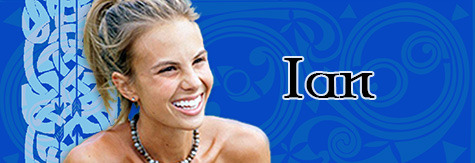
Raymond left, I'm extremely happy about that since he comes off as a huge comp threat and not at the hindrance to my own tribe! Premerge I want comp threats with me but he wasn't with me! This challenge I really want the reward, I have the effing clue, if I we get it, I can get Madeline to burn her searches to give me more insight on the island for my searches.

Oh boy this challenge is about to be.......... not fun. 1/3 of our tribe is present. 1/2 are asleep and the other 1/6 is Madison and she's NEVER HERE jfkldsjflas I can't wait to lose!!!!!!!!!! Logan and I are gonna try to pull this out anyway but

who tf designed this challenge! it makes me mad. i better get some sort of advantage outta this grr.

We stan being the only one awake! LOL but it's fine I'm gonna stay up late and chat with my friends I haven't talked to in a while. But this game... I love it! I love all comps. So cute. But also ... tag yourself ready: On 10/20/17, at 10:10 PM, charlotte (themyscira host) wrote: > f4 On 10/20/17, at 10:10 PM, jaiden nolan wrote: > fact On 10/20/17, at 10:10 PM, Jack (Ginga) wrote: > fast On 10/20/17, at 10:10 PM, Emily wrote: > free On 10/20/17, at 10:10 PM, rhone (ios host) wrote: > fork On 10/20/17, at 10:10 PM, Jordan Pines wrote: > fate All of these ... tell a lot about a person. I'm a psychic. This means things. Jack is fast and this has been proven with this challenge. Emily is free meaning ... I don't know but it's very me. Rhone is a fork and I think that suits him and Jordan is fate because like idk. It just SAYS THINGS about us okay Also I feel bad volunteering Amanda to sit out but :-/ she's less active than the boyz and Andreas will help out once he wakes up. I'm silly to think that the Europeans wouldn't be able to help this round! Because they can cover the graveyard shifts for us hehehehehehehehehe HA I LOVE IT thank u europe

I love this challenge! And right now, we just passed Hippolyta and we're two points away from passing Antiope. This is great! Like we're so close! And right now, we're not going to tribal! But we still have until 10PM tonight... Hopefully we can just build up more of a lead and keep ourselves safe. I'm scared!!!!!!!!!!!

On 10/21/17, at 12:55 PM, Ruthie wrote: > loser On 10/21/17, at 12:55 PM, Jordan Pines wrote: > Loser what they’re gonna be by 10PM tonight hehe

HONESTLY, I know this was last challenge but I'm still pissed about the music video challenge. HOW WE GOT DINGED ON PARTICIPATION WHEN WE HAD OUR ENTIRE TRIBE IN IT MAKES NO SENSE TO ME. OR CREATIVITY. OR PROPS. I MADE SLIME, I GOT A SLOTH PUPPET INVOLVED, WE MADE BLOOD, WE HAD WIGS. IT WAS A SPOOKY SONG FOR HALLOWEEN. We were robbed and whoever this Kayla person is I'm literally coming for you.

Yeahhhhh we probably lost this one. I can just hope the bond I sparked with Jaiden holds true, Madeline will work with me I know,(we swapped actual phone numbers so we can't be quoted when we talk bout the vote, iconic) and Toph should be on board as long as it isn't him. I'm looking at taking out Billy or Ruthie

God F U C K I N G damn ITJDFJCSAKFJLSK;D I LITERALLY SAID THE SECOND I DECIDE TO ACTUALLY TAKE A SHOWER AFTER WAITING OVER AN HOUR FOR THE NEXT LETTER WORD COMBO...... THE HOSTS WOULD SEND IT AND GUESS WHAT THEY DID? THEY SENT IT RIGHT WHEN I GOT INTO THE SHOWER AND IM SO ANGRY!!!!!!!!!!!!!!!!!!!!!!!!!!!!!!!!!!!!!!!!!!!!!!!!!!! but this is still fun u know I'm just pissed the heck off

Just send us to tribal already, this challenged f**ked our sh*t up fam.

I really hate feeling like I'm giving 120% on challenges and everyone else on my tribes aren't and I DIDN'T EVEN REALLY MEAN TO SIGN UP FOR THIS SO IT MAKES NO SENSE TO ME.

Word Up should just be named whose the fastest cheater. NO ONE KNOWS A 17 LETTER WORD STARTING WITH Q OR SOME SH*T. It just makes this whole thing cater to a lack of sportsmanship but it does show whose willing to cheat and that is telling for later in the game.

My tribe right now- [10/21/17, 7:20:00 PM] jaiden nolan: SHE says she thinks a pipe burst and that’s why the ceiling was leaking......not at all that she flooded a fucking bathroom....... [10/21/17, 7:20:12 PM] Ian Layne: WHO FLUSHES PAPER TOWELS? [10/21/17, 7:20:34 PM] jaiden nolan: okay but who flushes less than five paper towels and has it clog [10/21/17, 7:21:06 PM] jaiden nolan: like I know for a fact I’ve accidentally flushed things like paper towels, baby wipes, makeup wipes, etc and not had anything happen [10/21/17, 7:21:26 PM] Ian Layne: She took a mega dump and was embarrassed, I'm calling it [10/21/17, 7:21:53 PM] Madeline The Juicy Goose: Sounds like when I had a green bagel on st Patrick’s day [10/21/17, 7:22:06 PM] Ruthie: oh yikes [10/21/17, 7:23:19 PM] Ian Layne: I once drank too much at a bowling alley and had to get rid of my underwear so I flushed it, fun fact

Everyone is saying we can come back, we can come back! No it's mathematically impossible for us to comeback, never mind the variables of the other tribes do you really think 12 points is possible in one hour? We didn't defend a 13 point lead on Man Lips. We going to tribal Hippos

So! We thought for sure that we'd have to go to tribal, but as GOD would have it, we don't have to!! Menalippe? More like men-a-leaping to conclusions am I RIGHT

i am so sad that we lost i just need to make sure i'm not on ANYONE's bad side so i can stay :)

i am sad that we lost immunity, but now is the time to vote someone out. i think we need to vote out madeline because she is such a big threat to my game and i am pretending to talk on call about what i am reading this makes no sense also i think that she is going after billy too strong hehe

Me because no tribal: https://tmblrsurvivorextra.tumblr.com/post/166663831976

Hello my sunshines! WHAT IS GOING OOONNNNNNNNN! "Not much." "OK, cool." So, what happened this round? Not much. OK, cool. But really, the 24h challenge was cool, but Emily really carried our tribe. I got to chat a bit with Kai, finally, and he suggested that both of us should stick together with Emily - something I wholeheartedly agree with. Even if I don't trust Kai very much. We also agreed that SHOULD our Tribe lose, we'd go after Madison, since she's kinda invisible. Logan is in a similar position like me, not too revealing, but there and involved. I don't worry much about Amanda atm. She isn't participating much atm, so both our tribe and her old tribe would agree to vote her out at merge or something surely. She isn't a valuable ally to me either. I feel like I'm in a good spot atm and I hope that Ian and Billy survive todays Tribal Council! So I'll just leave you with my favourite quote from the last challenge: "Andreas scores for Menalippe with Circumcision!" SCORE!

Emily just suggested an alliance of me, Kai, and herself. Perfect. I won her over a little bit, and I think I got her to trust me a little more. I told her Dan and Raymond were my closest allies and they both got early boots, which they didn't deserve (true!), but I also told her I want revenge. That means Amanda and Jaiden are first on my hit list, next comes Jordan Pines. Not only did he probably help kill Raymond (fuck if I watch tribal) but he's also a MASSIVE threat. So gotta go. Updates to come~

Ian is taken way too long to respond to my simple question of ‘is billy still the plan’ what the heck

Well this vote is gonna be a rollercoaster ride for me due to Billy and Toph scrambling, but at least going forward(as long as I don't go tonight) Ruthie sold Jaiden down the river to Billy and not me about throwing Billy's name out. Seems like Madeline and I have protected ourselves well enough for this vote, but we shall see.

What is even HAPPENING why am i listening to JAIDEN

Nervous poop central, now boarding. I got a little mixed up in the chaos of pretribal anxiety because we were so close to having a stress-free vote, and Billy started scrambling. I crack so easily under pressure and for some reason, I just can’t stand being voted out so I did what I had to do in order to keep my name off the chopping block. I guess this includes forcing a clean vote to get messy and getting everybody to draw a colored rock... I think Ruthie is down for that. I told her to vote Toph with me and Billy in case of an idol and I don’t know if she IS or isn’t. But either way, my game will be damaged after the tie happens. My alliance will know I turned and my only escape route is to draw rocks with them involved ... fuck. I don’t know what’s gonna happen. The trust I established with them is thrown out the window if we tie. Idk what Ruthie’s intentions are but we’ll see :/ I’m scared. So scared.

[10/22/17, 9:14:04 PM] jaiden nolan: Ruthie. If you draw the bad rock I’ll play my advantage on you. I doubt we will go back to rocks [10/22/17, 9:14:15 PM] jaiden nolan: I love Ian and Madeline too but like, we can be a tbreesome with Billy if he stays JAIDEN IS INSANE WHY THE HECK DID I LISTEN TO HIM

I can't believe my number one in this game is going to be JAIDEN i don't understand how i trust him so much all of a sudden, this was not who was supposed to be my ride or die but here i am about to draw a ROCK.

I........ Jaiden said I was going to be safe in the redraw and DOT DOT DOT it's okay, it was fun I'm glad I got to go to rocks without being safe even though I hate that one was drawn for me! I've had fun playing this season and can't wait to see who wins the game!

GUESS I GOTTA ADD EVERYONE ON HIPPO TO MY HIT LIST HUH

My tribe? Assholes. Ruthie did not deserve that at all. And what's worse is none of them have my back. I want to hope Jaiden does, but he was just as on board for me to go until rocks was an option. I'm here to cause chaos now, and the silent people on my tribe better pray to god that I don't find an advantage or something. The best is, they made me sit out. And then I was targeted for not pulling my weight. Fuck. Y'all. Like mccuse me? It wasn't my fault that THE TRIBE decided I would sit out. I didn't ask to. And then THEY LOSE. THEY. FUCKING. LOST. UGH then they're all gonna lie to me. Where's that lasso of truth when you need it?

Fuck you and all your flash games R U T H I E W A S R O B B E D and I can’t believe I’m going to tribal in two days HUH SKSBSJSHEJ

I can’t believe that just happened. Honestly, poor Ruthie. She didn’t deserve to go out to rocks. For a moment I really thought that maybe my messy moves would work out for once, but NOPE LOL. I dunno, as sad as I am for Ruthie, I’m living for the utter chaos around camp. I can’t say I didn’t do something wild and reckless for the sake of having fun, and although this will probably send my ass out premerge, I played the messiest move I could think of. Unfortunately it was at Ruthie’s expense, but you win some and you lose some. There’s gonna be a LOT of heat on me the next few days. I’m gonna continue to do my best in the challenges and hopefully we’ll get a good immunity streak going until a swap happens. Tonight was the most fun I’ve had in a while, tbh.

This is literally me right now. http://78.media.tumblr.com/5180e47f3f3a1ad0bd0f04a6742989cd/tumblr_oxoavge6N71qd49gbo2_540.gif They're not gonna like me now that I'm frosty.

MY FIRST TRIBAL AND MY FIRST ROCKS AND I'M THE FIRST ONE SAFE.
0 notes